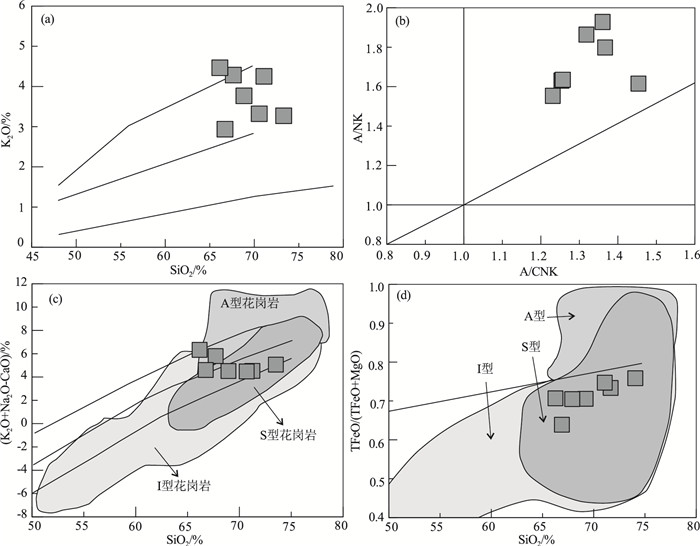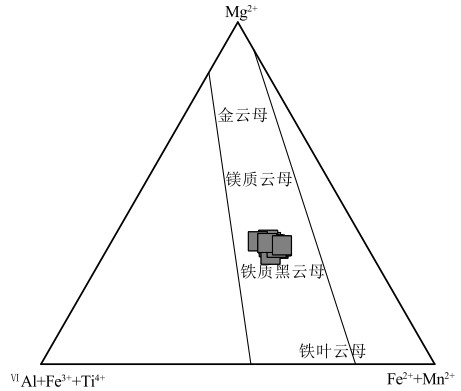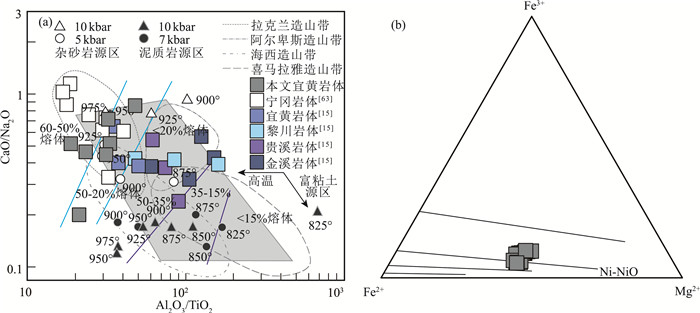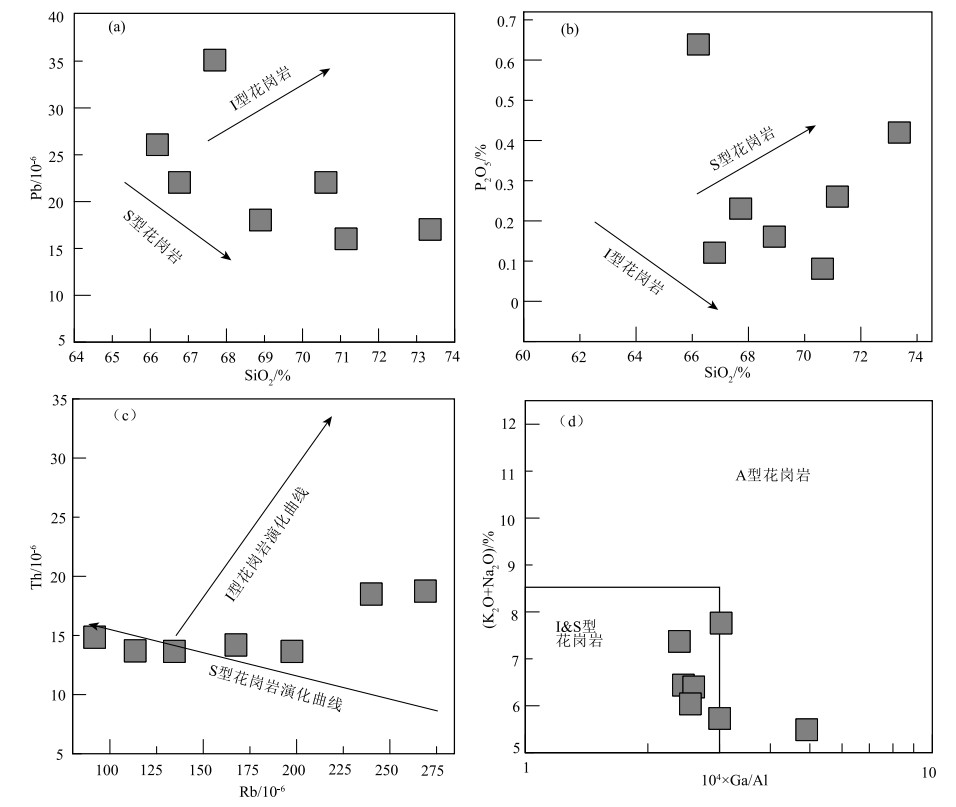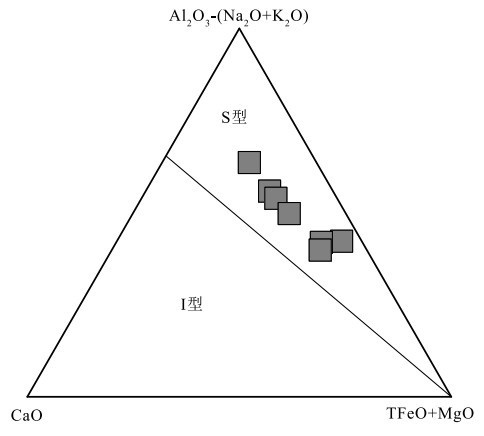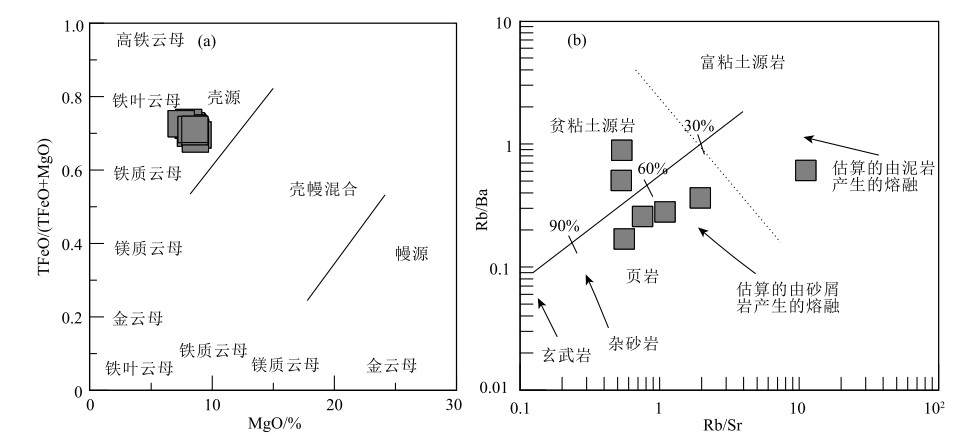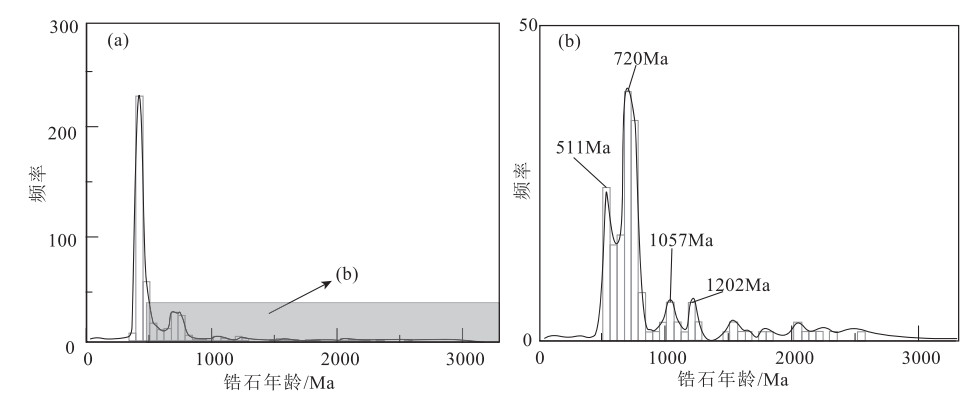Genesis of the Yihuang strong peraluminous S-type granite in Jiangxi Province and its constraints on Early Paleozoic intracontinental orogeny in South China
-
摘要:
宜黄花岗岩位于江西省中部宜黄县东南部,属武夷地块,主要岩石类型为二云母二长花岗岩。锆石U-Pb同位素测年表明,宜黄岩体形成于448 Ma。岩石具有高的SiO2、K2O、稀土元素总量(ΣREE=164.29×10 -6~256.66×10 -6)、CaO/Na2O值、A/CNK(1.23~1.45)、Rb/Sr值,以及低的P2O5、TiO2、TFeO/MgO、Al2O3/TiO2、Nb、Sr等值;轻稀土元素相对富集((La/Yb)N=12.02~34.43),具有中等负Eu异常(δEu=0.38~0.77),低εNd (t)值(-8.22~-13.93),高(87Sr/86Sr)i=(0.71283~0.72410)。锆石176Hf/177Hf值为0.28155~0.28250,εHf(t)值为-33.15~10.45。全岩Nd同位素二阶段模式年龄为1.99~2.31 Ga,锆石Hf同位素二阶段模式年龄为1.24~3.48 Ga。上述特征表明,宜黄花岗岩具有与强过铝质S型花岗岩类似的特征。宜黄花岗岩中黑云母富含Fe、Mg、Ti;白云母Ti、Al、Na含量高,Fe含量低。综合锆石饱和温度计、黑云母地质温度计、白云母地质压力计、锆石Ce异常等,宜黄花岗岩可能为华南元古宙地壳长石石英质岩石在高温、中等压力(9.5 kbar)和低氧逸度条件下部分熔融而成。在华南早古生代陆内造山作用的背景下,岩石圈拆沉作用引发上涌的地幔岩浆提供热,使华南元古宙地壳岩石发生部分熔融,形成宜黄花岗岩。
Abstract:The Yihuang granite is located in the southeast Yihuang county of central Jiangxi Province, which belongs to the Wuyi terranes.The main lithology of the Yihuang granitoids is two-mica monzogranite.Zircon LA-ICP-MS U-Pb dating indicates that the Yihuang granitoid formed at 448 Ma.The Yihuang granitoid is characterized by high contents of SiO2, K2O, ΣREE(164.29×10-6~256.66×10-6), CaO/Na2O, A/CNK(1.23~1.45), and Rb/Sr, as well as low contents of P2O5, TiO2, TFeO/MgO, Al2O3 / TiO2, Nb, and Sr.They are enriched in LREE relatively to HREE((La/Yb)N = 12.02~34.43)with moderate Eu anomalies(δEu = 0.38 ~ 0.77).The Yihuang granite displays low εNd (t)=(-8.22 ~ -13.93)and high(87Sr / 86Sr)i=(0.71283 ~ 0.72410).Zircon 176Hf/177Hf and εHf (t)values of the Yihuang granite are 0.28155~0.28250 and -33.15 ~ 10.45, respectively, with the corresponding two-stage Nd isotopic model ages of 1.99 ~ 2.31 Ga and two-stage Hf isotopic model ages of 1.24~3.48 Ga.The characteristics mentioned above show that the Yihuang granite is similar to the strongly peraluminous S-type granitoid.The biotite in the Yihuang granite is enriched in Fe, Mg, and Ti, and the muscovite has high contents of Ti, Al, Na, and low content in Fe.Combined with zircon saturation thermometers, biotite geothermometer, muscovite geobarometer, and zircon Ce anomalies, the Yihuang granite may be formed by the partial melting of the Proterozoic felsic crust of South China under high temperature, medium pressure(9.5 kbar)and low oxygen fugacity.Under the Early Paleozoic intra-continental Orogeny, the upwelling of mantle caused by the lithospheric delamination provided heat that would have triggered the partial melting of the Proterozoic crust of South China to generate the Yihuang granite.
-
受复杂地形地貌、地质构造、强震和强降雨等因素影响,中国地质灾害极发育[1],特别是在青藏高原地区,发育一系列大型—巨型滑坡,危害极严重。青藏高原东部断裂广泛发育,断裂带规模大且活动性强,强震频发,受历史强震影响,区内地震诱发滑坡-堵江-溃坝等次生地质灾害危险性高[2-5]。强烈地震时,在高山峡谷地区,地震诱发的地质灾害危害程度和影响范围往往比地震直接造成的危害更大、分布范围更广[6-9]。据统计,诱发区域性地震滑坡的最小震级约为Ms 4级,最小地震烈度约为Ⅵ度[10-12]。研究表明,当强震Ms≥7.0级时,地震引发的滑坡危害程度尤为显著[13-14],2008年四川汶川Ms 8.0级地震触发的地质灾害达15000多处,灾害导致两万余人死亡,在所有隐患点中滑坡占比高达40%[7]。目前,关于地震滑坡危险性评价的研究成果较丰富,但由于中国地质灾害的发育条件和分布规律较复杂,空间数据质量和各类危险性评价模型方法具有一定的局限性,难以采用统一的模型方法开展危险性评估,尤其是活动断裂带等地震高发区域的潜在地震滑坡预测研究尚需加强[15-16]。
鲜水河断裂带位于青藏高原东部,断裂带北起甘孜东谷附近,向南经炉霍、道孚至石棉县,总体走向北北西,呈略向北东凸出的弧形,是古生代形成的一条大型左旋走滑断裂[17-22]。鲜水河断裂由9条分支断裂组成,沿线历史地震频发、地震滑坡危害严重[17-18, 23-24]。如1786年由磨西Ms 73╱4级地震触发的摩岗岭滑坡造成大渡河阻断,溃坝后的泥石流等到达下游石棉县城境内,造成数万人死亡[25]。据前人研究,鲜水河断裂带未来具有发生Ms 6~7级强震的可能性[24],该区正在规划建设川藏铁路等工程,铁路建设面临地震滑坡的风险较高,进行鲜水河断裂带地震滑坡预测评价研究具有重要意义[24]。
目前,评价地震滑坡危险性的方法主要有数理统计模型和确定力学模型2种方法。数理统计模型评价侧重对现有滑坡与其影响因子间的分析统计,确定力学模型中的Newmark模型方法适用发震构造清楚或地震动参数记录较完整的情况,注重震后地震滑坡影响要素分析和危险性评价[26]。已有研究基于Newmark模型对汶川地震、尼泊尔地震等诱发的地震滑坡进行危险性评价,获得了较精确的结果[27-29]。因此,本文以鲜水河断裂带全线两侧约20 km范围为研究区,通过遥感解译和野外地质调查在区内共发现399处历史地震滑坡,采用Newmark模型对鲜水河断裂带地震滑坡进行危险性分区评价。研究结果可为该区地质灾害防治和川藏铁路等重大工程建设提供参考和指导。
1. 地质背景
鲜水河断裂带平均海拔在3000 m以上,地形起伏度在1000 m/km2以上,坡度多处于20°~40°,为典型的高山峡谷地区。研究区气候垂直分带较明显,降雨量区域分布差异较大。鲜水河断裂带由炉霍断裂、道孚断裂、乾宁断裂、雅拉河断裂、中谷断裂、色拉哈-康定断裂、折多塘断裂、木格措南断裂和磨西断裂9条分支断裂组成(图 1),均为全新世活动断裂[17-18, 23-24, 30]。
自1725年至今,沿鲜水河断裂带发生8次Ms≥7级的强震,其中1973年发生的炉霍Ms 7.9级地震是鲜水河断裂带内有记载的震级最大的一次地震,距今最近的一次强震是1981年发生的道孚Ms 6.9级地震[23, 31]。2014年康定地区附近发生了Ms 5.9及Ms 5.6级2次地震,但释放的能量远小于自1955年康定Ms 7.5级地震以来积累的能量,研究认为,未来一段时间内在色拉哈-康定段具有产生Ms 6~7级以上强震的风险[24, 32]。
2. 鲜水河断裂带历史地震滑坡发育分布特征
2.1 地震滑坡空间分布特征
地震滑坡是由地震作用或地震力触发的一种滑坡类型,指地震震动引起岩体或土体沿一个缓倾面剪切滑移一定距离,斜坡岩体或土体脱离滑源区,瞬间失稳的一种地质现象[33-35]。由地震引起的地质灾害有时远超过地震作用本身造成的危害,如磨西Ms 73╱4地震、炉霍Ms 7.9地震都造成巨大的破坏,诱发大量的地震滑坡。历史记录和调查研究认为,鲜水河断裂带的地震滑坡主要分布在地震烈度Ⅷ~Ⅹ度区,空间上主要位于断裂带两侧2 km范围内[36]。结合野外地质调查和鲜水河断裂带地震滑坡的发育规律,可将断裂带分为3段,东谷—八美段河谷较宽,地震滑坡以蠕滑下错为主,后壁较明显,堆积层较薄,滑体主要由第四纪堆积物组成;在八美—康定段,八美土石林构造破碎和风化强烈,地质灾害发育,折多山段为高山风化冻融地貌,灾害发育较少;康定—磨西段河谷变窄,受大渡河及大渡河断裂的影响,滑坡较发育,堆积体主要为碎块石和第四纪堆积物。
较典型的1973年四川省炉霍县的Ms 7.9级地震,震源深度17 km,震中烈度Ⅹ度。地震造成2175人死亡,2756人受伤,极震区内房屋倒塌严重,崩塌、滑坡等地震次生地质灾害对公路交通造成了严重影响。由炉霍地震触发的滑坡有160多处[8, 37],多数集中分布于朱倭—仁达之间(图 2),在断裂带两侧各2 km的范围内其分布与地表破裂带高度重合,主要分布于地震烈度Ⅷ~Ⅹ度区,滑坡破坏形式以崩塌和溜滑为主,发生坡度主要为30°~50°[38]。
![]() 图 2 1973年炉霍Ms 7.9级地震地质灾害分布图[38]Figure 2. Distribution map of geological hazards during the Luhuo Ms 7.9 earthquake in 1973
图 2 1973年炉霍Ms 7.9级地震地质灾害分布图[38]Figure 2. Distribution map of geological hazards during the Luhuo Ms 7.9 earthquake in 19732.2 地震滑坡主要类型
通过遥感解译、历史资料收集分析和1:5万地质灾害调查发现,在鲜水河断裂带两侧20 km范围内共有399处历史地震滑坡[38](图 3)。地震滑坡总体表现为高位远程、一滑到底、裂而未滑等特点。
(1) 高位远程滑坡
高位远程滑坡指滑体重心和剪出口位置高,滑坡剪出口与滑坡前缘的高差较大,滑源区岩体受山脊拉应力作用致使裂缝扩展,在中国青藏高原地区分布广泛,具有较大势能的滑坡,常伴有滑坡-堵江- 溃坝等链生地质灾害特征[39-40]。区内最典型的高位远程滑坡有八美镇幸福沟滑坡(图版Ⅰ-a)、摩岗岭滑坡等。幸福沟滑坡左侧以陡坎为界,右侧以冲沟为界,后缘以高陡基岩后壁为界,前缘以河流为界,滑动后已经挤压河道,该滑坡纵约130 m,宽约60 m,推测堆积体厚约10 m,体积约为7.8×104 m3。
(2) 一滑到底型滑坡
一滑到底型滑坡是在地震震动的作用下,原来处于接近平衡的斜坡松散堆积物重心失稳,堆积体从坡顶启动,直达最低处的坡脚或河谷地区[37],如泸定县河口村河庄子滑坡(图版Ⅰ-b)和四十七道班滑坡(图版Ⅰ-c)。河庄子滑坡平面形态呈舌型,后缘以基岩为界,左右侧以下错陡坎为界,中部和前缘存在平台,滑坡纵长约620 m,宽350 m,厚约10 m,体积约为1.53×106 m3,目前该滑坡稳定性较好。
(3) 裂而未滑型滑坡
裂而未滑型滑坡指在强烈的地震作用下,震区的山体发生大范围破裂,形成了大量拉裂缝,但整个山体松而未动、裂而未滑,处于临界稳定状态,在外力作用下极易发生滑动[41]。如道孚县东南足湾村滑坡为典型的裂而未滑型滑坡,该滑坡拉裂缝极发育,稳定性较差,在强降雨或地震作用下,极易发生滑动[36]。
2.3 典型地震滑坡发育特征
(1) 摩岗岭高位远程滑坡-堵江-溃坝灾害链
摩岗岭滑坡位于四川省泸定县大渡河右岸,鲜水河断裂带的分支断裂磨西断裂从滑体中部穿过,由1786年6月1日Ms 73╱4级地震诱发形成[25, 36]。该滑坡后缘呈典型圈椅状,地震的强大动力作用,使坡体后壁的岩体被抛射到大渡河左岸,堆积体体积约1.8×108m3(图 4)。滑坡造成大渡河堵塞,在堰塞坝堵断大渡河9天后发生溃决,形成的泥石流、洪水造成石棉县城境内数万人死亡[25, 36, 42]。
![]() 图 4 摩岗岭滑坡全貌图和工程地质剖面图a—摩岗岭滑坡全貌图(镜像SWW);b—摩岗岭工程地质剖面图[25]Figure 4. The overall picture and engineering geological profile of the Mogangling landslide
图 4 摩岗岭滑坡全貌图和工程地质剖面图a—摩岗岭滑坡全貌图(镜像SWW);b—摩岗岭工程地质剖面图[25]Figure 4. The overall picture and engineering geological profile of the Mogangling landslide(2) 炉霍55道班滑坡
55道班滑坡位于四川省炉霍县317国道附近,鲜水河断裂带分支断裂从坡体中部穿过,后壁高陡,为典型的地震滑坡[8, 39]。该滑坡平面形态呈舌型,滑坡体积约1000×104m3,滑坡规模为特大型,在平面上分为Ⅰ区、Ⅱ区和Ⅲ区3个区域(图 5)。目前滑坡北侧前缘变形破坏迹象明显,整体稳定性差,坡体中下部发育拉裂缝,引起地面隆起、挡墙开裂和317国道改线绕行[36]。
![]() 图 5 55道班滑坡典型地貌图和工程地质平面图a—55道班滑坡工程地质平面图[36];b—55道班滑坡发育全貌图(镜像NW); Qh—冰川冰水堆积物;Qp—残坡积物;T3y1—变质砂岩夹板岩;T3ln2—砂板岩互层;T3ln1—变质砂岩夹板岩、砾岩;T3r2—玄武岩、凝灰岩、板岩;T3r1—板岩夹薄层变质砂岩;T2z2—变质砂岩夹板岩;T2z1—变质砂岩、板岩、灰岩;T1b—板岩、灰岩、角砾岩Figure 5. Typical geomorphological map and engineering geological plan of the 55 Daoban landslide
图 5 55道班滑坡典型地貌图和工程地质平面图a—55道班滑坡工程地质平面图[36];b—55道班滑坡发育全貌图(镜像NW); Qh—冰川冰水堆积物;Qp—残坡积物;T3y1—变质砂岩夹板岩;T3ln2—砂板岩互层;T3ln1—变质砂岩夹板岩、砾岩;T3r2—玄武岩、凝灰岩、板岩;T3r1—板岩夹薄层变质砂岩;T2z2—变质砂岩夹板岩;T2z1—变质砂岩、板岩、灰岩;T1b—板岩、灰岩、角砾岩Figure 5. Typical geomorphological map and engineering geological plan of the 55 Daoban landslide3. 基于Newmark模型的地震滑坡危险性评价
地震滑坡危险性评价指将地震作为潜在不确定因素,分析潜在地震及其诱发滑坡的时空分布概率,具体的危险性描述要素包括潜在地震滑坡的位置、体积或面积、滑坡类型和运移速度,以及一定时期内的发生概率等[43-44]。地震滑坡危险性评价的研究逐渐从定性向半定量、定量化发展,主要有基于统计分析的综合评价法[43-44]、基于极限平衡理论的拟静力法[45-47]、基于边坡累积位移的Newmark模型方法[48-50]。其中,Newmark方法适用于发震构造清楚或地震动强度和参数记录较完整的情况,注重震后对地震滑坡影响要素分析和危险性反演评估[44]。因此,本文采用Newmark模型开展鲜水河断裂带地震滑坡危险性评价。
3.1 Newmark斜坡位移模型
Newmark斜坡位移模型是英国科学家Newmark于1965年基于无限斜坡的极限平衡理论提出的一种地震滑坡危险性评价方法[48]。该模型把滑体看作是一个刚体,对坡体的静态安全系数和临界加速度进行研究,当外力的作用低于临界加速度时,坡体不会发生位移;当外力的作用高于临界加速度时,会出现有限位移;在地震作用下,则会产生滑动的永久位移。通过二次积分外载荷加速度和临界加速度的差值,即可获得永久位移(公式(1))[48, 51-53]。
Dn=∫t∫t[a(t)−ac]dts (1) 本文采用概率地震条件下的地震动峰值加速度作为潜在地震参数,采用的地震滑坡危险性计算步骤主要有:①利用岩土体力学参数和斜坡坡度,计算斜坡静态安全系数(Fs);②利用斜坡静态安全系数(Fs)和坡度,计算获得斜坡临界加速度(ac);③利用斜坡临界加速度(ac)和地震动峰值地面加速度(PGA),计算概率地震扰动下的坡体累积位移(Dn);④根据斜坡位移和滑坡发生概率的统计规律,预测评价概率地震滑坡危险性[9, 50, 53];⑤最后,利用历史地震滑坡对地震滑坡危险性分区结果进行检验。鲜水河断裂带地震滑坡危险性评价流程图如图 6所示。
3.2 Newmark模型评价过程
(1) 静态安全系数(Fs)
根据基于滑块极限平衡理论的斜坡安全系数公式(公(2))[49, 53],利用岩土体物理力学参数和坡度,计算得到斜坡静态安全系数(Fs)。
Fs=c′γtsinα+tanφ′tanα−mγwtanφ′γtanα=c′γtsinα+(1−mγwγ)×tanφ′tanα (2) 式中:c'为粘聚力(kPa);φ'为有效内摩擦角(°);γ为岩体重度(kN/m3);γw为地下水重度(kN/m3);t为潜在滑体厚度(m);α为潜在滑面倾角(°);m为潜在滑体中饱和部分占总滑体厚度的比例。
(2) 斜坡临界加速度(ac)
斜坡临界加速度(ac)指在地震作用下,滑块的下滑力与抗滑力相等时对应的地震动加速度。通过比较无外力作用和地震作用下滑块的受力状态,建立滑块在地震作用下的极限平衡状态方程,利用安全系数(Fs)推导出ac的计算公式(公(3))[54]。
ac=(Fs−1)gsinα (3) 式中:g为重力加速度(m/s2);α为滑面倾角(°)。
(3) 地震诱发斜坡位移(Dn)
通过分析大量地震加速度记录和地震滑坡实例,获得地震诱发斜坡累积位移(Dn)与临界加速度(ac)和地震动峰值加速度(PGA)的相互关系式(公式(4))[55]。其中,斜坡累积位移(Dn)与地震动峰值地面加速度强度(PGA)成正比,与斜坡临界加速度(ac)成反比[56]。采用中国第五代地震动峰值地面加速度计算鲜水河断裂带区域50年超越概率10%地震诱发斜坡位移(Dn)。
lgDn=0.215+log[(1−acPGA)2.341(aiPGA)−1.438] (4) 式中:ac为斜坡临界加速度;PGA为地震动峰值加速度。
(4) 地震诱发滑坡危险性(P)
地震诱发斜坡位移并不一定会发生坡体滑动,只有当斜坡位移累积到一定程度时,坡体才会发生失稳,并沿滑动面下滑产生滑坡灾害。因此,根据地震斜坡位移和滑坡发生概率之间的相关关系(公式(5))[49],计算地震作用下的滑坡发生概率(P)。
P=0.335[1−exp(−0.048D1.565n)] (5) 式中:Dn为斜坡位移。
4. 鲜水河断裂带地震滑坡危险性评价结果
4.1 地震滑坡危险性计算
(1) 地形坡度
据地震滑坡危险性评估经验,地形坡度小于10°的斜坡通常较稳定,很少发生大规模的滑坡,因此,地形坡度小于10°的斜坡不参与计算[27-28]。研究区的地形坡度起伏较大,大渡河流域、鲜水河流域等地坡度较大(图 7-a)。
![]() 图 7 鲜水河断裂带地形坡度和工程地质岩组(岩组编号见表 1中ID)a—地形坡度分布图;b—工程地质岩组分布图Figure 7. Topographic slope and engineering geological rock group of Xianshuihe fault zone表 1 鲜水河断裂带工程地质岩组与物理力学参数Table 1. Physical and mechanical properties of engineering geological rock groups in the Xianshuihe fault zone
图 7 鲜水河断裂带地形坡度和工程地质岩组(岩组编号见表 1中ID)a—地形坡度分布图;b—工程地质岩组分布图Figure 7. Topographic slope and engineering geological rock group of Xianshuihe fault zone表 1 鲜水河断裂带工程地质岩组与物理力学参数Table 1. Physical and mechanical properties of engineering geological rock groups in the Xianshuihe fault zoneID 工程地质岩组名称 c'/kPa ϕ'/° γ/(kN·m-3) 1 坚硬的厚层状砂岩岩组 26 33 26 2 较坚硬—坚硬的中—厚层状砂岩夹砾岩、泥岩、板岩岩组 25 32 25 3 软硬相间的中—厚层状砂岩、泥岩夹灰岩、泥质灰岩及其互层岩组 25 32 24 4 软弱—较坚硬薄—中厚层状砂、泥岩及砾、泥岩互层岩组 20 27 23 5 软弱的薄层状泥、页岩岩组 24 31 21 6 坚硬的中—厚层状灰岩及白云岩岩组 23 31 25 7 较坚硬的薄—中厚层状灰岩、泥质灰岩岩组 23 30 24 8 软硬相间的中—厚层状灰岩、白云岩夹砂、泥岩、千枚岩、板岩岩组 22 29 23 9 较坚硬—坚硬薄—中厚层状板岩、千枚岩与变质砂岩互层岩组 21 28 22 10 较弱—较坚硬的薄—中厚层状千枚岩、片岩夹灰岩、砂岩、火山岩岩组 28 35 21 11 坚硬的块状玄武岩为主的岩组 27 34 29 12 坚硬块状花岗岩、安山岩、闪长岩岩组 19 26 28 13 软质散体结构岩组 15 25 18 注:ID与图 7-b中的工程地质岩组号码一致,c'为粘聚力,φ'为有效内摩擦角,γ为岩体重度 (2) 工程地质岩组划分
综合考虑地质构造、地层年代、岩土体类型、岩体风化破碎程度等因素,将鲜水河断裂带地层岩性划分为13个工程地质岩组。根据《工程地质手册》 (第五版)[56],结合区内地层岩性分布与典型岩体的力学强度测试结果,获得工程地质岩组的物理力学参数。
(3) 静态斜坡安全系数计算
采用公式(2)计算静态安全系数(Fs),通过多次迭代循环计算,调整模型参数,使斜坡在无外力作用下的斜坡静态安全系数(Fs)大于1。因地形坡度小于10°的斜坡通常十分稳定,本文相应区域的斜坡不进行静态安全系数的计算,以此确定模型参数为:c'、φ'和γ。其中,C'为粘聚力,φ'为有效内摩擦角,r为岩体重度,具体参数值见表 1,γw=10kN/m3,t=2.5m,m=0.3,α取值为地形坡度(图 7-a)。计算得到的鲜水河断裂带斜坡静态安全系数(Fs)见图 8-a,具有较低静态安全性的斜坡沿深切河谷分布,总体上呈现北北东向;具有静态安全性较高的斜坡主要分布在地形坡度较缓的地区,如塔公草原附近静态安全系数大于5。
(4) 鲜水河断裂带临界加速度计算
据公式(3)利用静态安全系数(Fs)和斜坡坡度计算得到鲜水河断裂带斜坡临界加速度(ac)(图 8-b),与静态安全系数相对应,坡度越高的地区其稳定性越差,即静态安全系数越低,诱发斜坡失稳所需的临界加速度越小。在坡度较陡的斜坡上,临界加速度小于0.15 g,在坡度较缓的河谷、盆地和塔公草原,临界加速度大于0.6 g,最大值可达到0.98 g。
(5) 地震动峰值加速度
地震动峰值加速度用于计算地震诱发斜坡位移,采用中国第五代地震动峰值地面加速度分区值来计算鲜水河断裂带区域地震诱发斜坡位移(Dn)。据图 9-a显示,随着距离鲜水河断裂带越远,地震动峰值加速度值减小,在康定附近达到最大值0.4 g。
(6) 鲜水河断裂带斜坡位移计算
给定斜坡一个地震动值,当临界加速度相同时,斜坡将产生相同的位移[27]。根据式(4)计算得到鲜水河断裂带斜坡位移(Dn)。结果显示,斜坡位移较大的区域主要分布在临界加速度较小和地震动峰值加速度较大的区域,即康定—磨西段、大渡河流域及坡度较大的地区,位移可达10 cm以上(图 9-b)。
4.2 危险性分区与结果检验
利用Newmark模型计算获得鲜水河断裂带地震滑坡危险性分区,根据地震滑坡发生概率,参考《地质灾害危险性评估规范》(DZ/T 0286—2015)和国内外地震滑坡危险性分区研究成果[49],进一步把鲜水河断裂带划分为地震滑坡低危险区、中等危险区、高危险区和极高危险区(图 10),并统计历史地震滑坡在各分区中的分布(表 2)。结合已有地震滑坡点验证,各分区特点如下。
表 2 地震滑坡危险性分级统计Table 2. Seismic landslide hazards classification statistics地震滑坡危险区 分级面积/km2 分级面积比例/% 已发现的地震滑坡 滑坡数量/个 滑坡数量比例/% 滑坡面积/km2 滑坡面积比例/% 极高危险区 1931 6.28 140 35.09 57.76 70.62 高危险区 3619 11.77 114 28.57 15.34 18.75 中等危险区 10249 33.33 108 27.07 8.36 10.21 低危险区 14951 48.62 37 9.27 0.34 0.42 (1) 地震滑坡低危险区约占研究区面积的48.62%,主要分布在地形坡度较缓的东谷附近河谷地区及塔公草原地区,约有9.27%已调查发现的滑坡分布在地震滑坡低危险区。
(2) 地震滑坡中等危险区约占研究区面积的33.33%,约有27.07%已调查发现的滑坡分布在地震滑坡中等危险区,主要分布在鲜水河断裂带北段鲜水河河谷两侧坡度较缓的斜坡(图 10-a)。
(3) 地震滑坡高危险区约占研究区面积的11.77%,约有28.57%已调查发现的滑坡分布在地震滑坡高危险区,地震滑坡高危险区主要分布在康定市及周边地区(图 10-b)。
(4) 地震滑坡极高危险区约占区域面积的6.28%,约有35.09%已调查发现的滑坡分布在地震滑坡极高危险区,地震滑坡极高危险区主要分布在坡度较陡的大渡河流域和康定—磨西段(图 10-c)。
本文采用地质灾害危险性评价常用的成功率(ROC)曲线方法,对鲜水河断裂带地震滑坡危险性评价结果进行检验。ROC曲线下的面积值(AUC)越接近1.0,说明模型的构建效果越好,即评价结果越好;相反,若AUC值越接近0.5,说明模型的准确性越低[57]。本次鲜水河断裂带滑坡危险性评价结果的ROC曲线下方面积值为0.743(图 11),表明基于Newmark模型的鲜水河断裂带地震滑坡危险性评价结果具有较好的精度。
5. 讨论
5.1 鲜水河断裂带地震滑坡趋势
分析表明,已调查发现的399处历史地震滑坡主要沿地震动峰值加速度较高的区域分布。基于Newmark模型计算获得地震滑坡危险性分区,结果显示,有63.66%的地震滑坡分布在极高危险和高危险区。地震滑坡的发生受地震震级、震源深度、地形地貌、工程地质条件等因素影响。鲜水河断裂带构造活动强烈、工程地质条件较差,根据野外地质调查和地震滑坡危险性评价结果,鲜水河断裂带东南段的地震滑坡危险性较高。
前人研究认为,色拉哈-康定具有产生Ms 6~7级以上地震的风险[24, 32]。以上地震滑坡危险性评价结果显示,若沿鲜水河断裂带发生Ms 7.0级及以上强震,则康定周边、大渡河流域及康定—磨西段有较高的地震滑坡危险性。
5.2 鲜水河断裂带地震滑坡预测方法
王涛等[41]利用地震地质灾害形成和演化规律,提出广义的地震滑坡危险性评估框架。历史地震滑坡重点关注研究区历史强震,利用Newmark模型对历史地震诱发滑坡位移进行评估;同震滑坡的评估则是利用基础地质调查、遥感解译、地震动等参数,开展区域同震滑坡危险性评估;震后降雨滑坡结合地质灾害易发性进行地质灾害危险性评估[58];潜在地震滑坡主要依靠概率地震危险性分析方法,综合考虑区域工程地质条件与发震环境的相互作用,利用Newmark模型进行潜在地震滑坡危险性评估[59]。
层次分析法、信息量模型、加权线性叠加、支持向量机、逻辑回归等统计分析方法,具有数据量过大、不适合面积较大区域,忽视了与灾害问题的对应关系和适用条件等不足[60]。Newmark模型适用于发震构造清楚或地震动强度和参数记录较完整的情况,注重震后对地震滑坡影响要素的分析和危险性反演评估[44],可以利用中国第五代地震动峰值加速度计算当前地震动加速度下的潜在地震滑坡危险性,也可以通过阿里亚斯烈度(Arias)计算某次历史地震或设置的潜在地震点下的地震滑坡危险性。本文在考虑区域地震地质背景的基础上,基于Newmark模型方法的定量化评价优势,采用该方法开展鲜水河断裂带地震滑坡危险性评价。通过对比鲜水河断裂带地震滑坡危险性评估结果与区内历史地震滑坡分布,发现历史地震滑坡分布密集的区域与危险性评估结果中的极高危险区和高危险区分布较一致。
5.3 对重大工程规划建设的影响
鲜水河断裂带地处四川省境内川西地区,活动性强,未来具有发生强震的可能性[24]。根据鲜水河断裂带地震滑坡危险性评估结果显示,地震滑坡极高和高危险区主要分布在坡度较陡的大渡河流域和康定—磨西段、康定市及周边地区,研究区约有63.66%的历史地震滑坡分布在地震滑坡极高和高危险区。研究区城镇、公路等沿鲜水河、大渡河密集分布,且沿岸又是地质灾害高发区,部分居民点和公路存在地质灾害风险,城镇规划区应远离地震滑坡高危险区、河谷岸坡等地区;重要入藏公路G318穿越鲜水河断裂带地震滑坡高危险区,受到地质灾害严重威胁,需加强潜在地震诱发地质灾害防控意识、防护排查等处置措施;并且该区正在规划建设川藏铁路等重大工程,铁路建设面临地震滑坡的风险极高,规划铁路线经泸定县、康定市地震滑坡危险性较高的地区,但该路段以隧道为主,因此,铁路等工程规划建设需加强二郎山隧道、宝灵山隧道、郭达山隧道、康定隧道等的进出口地震滑坡危害评判及防控。
6. 结论
(1) 地震滑坡极高危险性区、高危险区、中等危险区和低危险区分别占研究区总面积的6.28%、11.77%、33.33%和48.62%,危险性较高的地区主要分布在康定—磨西段、大渡河附近及坡度较陡的斜坡上。
(2) 通过对比地震滑坡危险性评价结果与历史地震滑坡分布,发现已调查的399处地震滑坡有254处地震滑坡分布在地震滑坡极高和高危险区,与评估揭示的极高—高危险区分布较吻合,成功率(ROC)曲线检验结果显示,地震滑坡危险性评价的准确率为74.3%,评价结果精确度较高。
(3) 地震滑坡危险性分区受活动断裂和地形地貌影响显著,距离断层越近、坡度越大的斜坡,地震滑坡危险性越高。
(4) 根据危险性分区结果,若鲜水河断裂带发生强震,在大渡河流域及康定-磨西段有较高的危险性。川藏铁路经泸定县、康定地震滑坡危险性较高的地区,在铁路建设需加强铁路隧道口附近的地震滑坡危害评判及防控。
致谢: 东华理工大学孙立强老师及张林、朱坤贺等同学给予了帮助和指导;南京聚谱检测科技有限公司完成了本文地球化学样品的测试分析,在此一并表示感谢。 -
图 7 宜黄花岗岩黑云母分类图解[65]
Figure 7. Biotite classification diagram of the Yihuang granite
图 11 宜黄花岗Al2O3-(Na2O+K2O)-CaO-(TFeO+MgO)图解[71]
Figure 11. Al2O3-(Na2O+K2O)-CaO-(TFeO+MgO)diagram of the Yihuang granite
图 13 华南古生代花岗岩锆石年龄频率直方图[31]
Figure 13. Zircon age-frequency histogram of the Paleozoic granitoids in South China
表 1 宜黄花岗岩(17YH-03)LA-ICP-MS锆石U-Th-Pb测试结果
Table 1 LA-ICP-MS zircon U-Th-Pb results of the Yihuang granite(17YH-03)
样品点 含量/10-6 Th/U 同位素比值 年龄/Ma TTi/℃ 氧逸度 U Th 207Pb/206Pb 1σ 207Pb/235U 1σ 206Pb/238U 1σ 208Pb/232Pb 1σ 238Pb/232Pb 1σ 207Pb/206Pb 1σ 207Pb/235U 1σ 206Pb/238U 1σ 208Pb/232Th 1σ 17YH-03-01 756.18 169.08 0.22 0.0563 0.0010 0.6871 0.0124 0.0886 0.0017 0.0400 0.0025 7.0139 0.5025 464 39 531 7 547 10 793 49 17YH-03-02 111.71 130.88 1.17 0.0670 0.0016 1.0493 0.0316 0.1147 0.0032 0.0366 0.0008 0.8869 0.0321 837 51 729 16 700 18 726 17 17YH-03-03 204.73 186.88 0.91 0.0670 0.0015 1.0589 0.0285 0.1153 0.0024 0.0392 0.0014 1.2381 0.0464 837 46 733 14 703 14 777 27 17YH-03-04 1016.23 245.92 0.24 0.0561 0.0007 0.5582 0.0104 0.0726 0.0015 0.0228 0.0008 4.3833 0.1141 456 29 450 7 452 9 457 17 717 -21.01 17YH-03-05 118.50 111.83 0.94 0.0634 0.0019 1.0240 0.0300 0.1180 0.0027 0.0384 0.0020 1.1685 0.0314 722 62 716 15 719 16 761 38 17YH-03-06 198.91 75.88 0.38 0.1595 0.0024 9.0771 0.2401 0.4149 0.0100 0.1317 0.0035 2.7373 0.0765 2450 25 2346 24 2237 46 2501 63 17YH-03-07 134.65 83.16 0.62 0.1626 0.0025 8.6840 0.1921 0.3910 0.0088 0.1358 0.0051 1.7883 0.0692 2483 26 2305 20 2127 41 2573 91 17YH-03-08 107.43 71.96 0.67 0.1046 0.0026 4.1470 0.1107 0.2876 0.0061 0.0941 0.0025 1.7361 0.0681 1707 46 1664 22 1629 31 1818 47 17YH-03-09 75.43 42.73 0.57 0.0667 0.0023 1.2925 0.0433 0.1406 0.0032 0.0461 0.0015 2.0511 0.0607 827 73 842 19 848 18 912 29 17YH-03-10 136.65 55.33 0.40 0.0634 0.0013 1.0343 0.0304 0.1192 0.0028 0.0411 0.0008 5.3034 0.8685 721 44 721 15 726 16 814 16 17YH-03-11 164.25 92.88 0.57 0.0641 0.0009 1.0325 0.0229 0.1171 0.0022 0.0390 0.0007 2.3623 0.1625 745 30 720 11 714 13 773 13 17YH-03-12 415.86 216.03 0.52 0.0574 0.0010 0.5633 0.0146 0.0712 0.0013 0.0236 0.0005 2.2082 0.0557 505 39 454 10 444 8 472 10 885 -16.04 17YH-03-13 194.82 57.91 0.30 0.0580 0.0010 0.5674 0.0126 0.0715 0.0014 0.0228 0.0005 3.9654 0.1839 529 37 456 8 445 8 456 10 782 -26.44 17YH-03-14 441.22 34.23 0.08 0.0589 0.0007 0.7144 0.0136 0.0882 0.0014 0.0374 0.0020 27.7100 2.5308 562 27 547 8 545 8 743 39 17YH-03-15 160.47 212.97 1.33 0.0628 0.0016 1.0325 0.0316 0.1193 0.0024 0.0392 0.0013 0.8421 0.0511 700 54 720 16 726 14 778 25 17YH-03-16 151.11 66.03 0.44 0.0639 0.0020 1.0310 0.0413 0.1174 0.0028 0.0427 0.0019 2.4157 0.1333 738 66 719 21 716 16 845 37 17YH-03-17 153.67 65.03 0.42 0.0621 0.0020 1.0198 0.0434 0.1194 0.0033 0.0388 0.0014 3.2370 0.3983 679 68 714 22 727 19 769 27 17YH-03-18 527.33 175.60 0.33 0.0615 0.0008 1.0280 0.0253 0.1204 0.0025 0.0381 0.0011 4.0031 0.2943 658 26 718 13 733 15 756 22 17YH-03-19 1031.31 243.24 0.24 0.0553 0.0008 0.5487 0.0087 0.0720 0.0011 0.0220 0.0003 4.4331 0.1528 423 31 444 6 448 7 440 6 714 -16.99 17YH-03-20 967.27 37.99 0.04 0.0564 0.0009 0.5652 0.0103 0.0726 0.0012 0.0205 0.0008 57.5308 9.7256 467 35 455 7 452 7 409 16 752 -20.93 表 2 宜黄花岗岩主量、微量和稀土元素分析结果
Table 2 Major, trace elements and REE compositions of the Yihuang granite
样品号 17YH-02 17YH-03 17YH-05 17YH-06 17YH-07 17YH-08 17YH-10 样品号 17YH-02 17YH-03 17YH-05 17YH-06 17YH-07 17YH-08 17YH-10 SiO2 68.89 71.14 67.69 73.35 66.76 66.18 70.61 Nb 11.30 12.70 15.30 63.90 16.80 25.30 30.20 TiO2 0.49 0.33 0.48 0.55 0.64 0.51 0.66 Ta 0.90 1.20 1.40 7.80 1.30 2.30 1.80 Al2O3 15.87 15.77 15.92 11.68 14.96 16.01 12.42 Zr 205.00 174.00 185.00 314.00 139.00 332.00 197.00 TFe2O3 3.46 2.44 3.22 5.20 5.69 3.71 5.42 Hf 5.10 4.60 5.30 9.30 3.80 9.80 5.30 MnO 0.05 0.05 0.05 0.06 0.11 0.08 0.05 Pb 18.00 16.00 35.00 17.00 22.00 26.00 22.00 MgO 1.35 0.84 1.26 1.59 2.93 1.44 1.75 Th 13.65 13.70 13.65 18.75 14.20 18.50 14.85 CaO 1.94 1.88 1.62 0.45 1.45 1.49 1.26 U 1.94 3.21 3.78 27.70 3.61 5.72 3.14 Na2O 2.71 2.19 3.13 2.25 3.13 3.34 2.44 La 42.90 46.00 37.40 42.50 45.30 56.60 47.00 K2O 3.74 4.22 4.25 3.25 2.92 4.43 3.30 Ce 75.20 84.50 74.30 83.40 81.80 109.50 90.10 P2O5 0.16 0.26 0.23 0.42 0.12 0.64 0.08 Pr 7.27 8.29 7.53 8.97 8.17 11.45 8.99 烧失量 0.94 1.27 2.08 0.41 1.67 1.23 0.95 Nd 26.20 29.50 28.10 33.10 29.90 42.30 32.40 总量 99.60 100.39 99.93 99.21 100.38 99.06 98.94 Sm 4.10 5.42 5.48 6.74 5.50 8.52 6.02 TFeO 3.11 2.20 2.90 4.68 5.12 3.34 4.88 Eu 0.90 1.03 1.16 0.90 1.35 1.26 0.71 A/NK 1.86 1.93 1.63 1.62 1.80 1.55 1.64 Gd 3.06 4.91 4.36 5.97 5.18 8.17 5.12 A/CNK 1.32 1.36 1.25 1.45 1.37 1.23 1.26 Tb 0.37 0.73 0.58 1.02 0.80 1.38 0.71 Co 9.00 6.00 6.00 7.00 13.00 8.00 12.00 Dy 1.93 3.83 3.09 5.97 4.93 8.34 3.78 Cr 23.00 8.00 16.00 50.00 66.00 22.00 52.00 Ho 0.35 0.70 0.56 1.09 1.00 1.55 0.67 V 45.00 28.00 35.00 55.00 79.00 43.00 67.00 Er 0.91 1.71 1.51 2.79 2.91 4.02 1.64 Ni 10.00 8.00 12.00 13.00 27.00 25.00 23.00 Tm 0.13 0.22 0.21 0.38 0.41 0.52 0.21 Zn 78.00 60.00 74.00 115.00 69.00 125.00 116.00 Yb 0.84 1.27 1.36 2.32 2.54 2.70 1.26 Cs 7.68 5.37 14.25 20.50 17.35 14.55 2.42 Lu 0.13 0.18 0.20 0.34 0.39 0.35 0.20 Sc 7.00 5.00 6.00 11.00 13.00 11.00 9.00 ΣREE 164.29 188.29 165.84 195.49 190.18 256.66 198.81 Ga 20.50 21.60 20.10 30.30 20.10 25.60 19.70 Sn 3.00 3.00 4.00 9.00 4.00 10.00 3.00 Ba 763.00 122.50 675.00 424.00 624.00 631.00 174.50 Cu 5.00 5.00 18.00 35.00 43.00 1.00 47.00 Rb 134.50 113.50 197.50 269.00 167.50 240.00 91.80 (La/Yb)N 34.43 24.42 18.54 12.35 12.02 14.13 25.15 Sr 240.00 211.00 180.00 24.00 221.00 122.00 172.00 σEu 0.75 0.60 0.71 0.43 0.77 0.46 0.38 Y 9.60 19.10 15.20 29.60 29.50 46.80 18.10 注:A/CNK =Al2O3/(CaO+Na2O+K2O)(摩尔数);A/NK = Al2O3/(Na2O+K2O)(摩尔数);主量元素含量单位为%,微量和稀土元素含量单位为10-6 表 3 宜黄花岗岩Sr-Nd同位素组成
Table 3 Sr and Nd isotopic compositions of the Yihuang granite
样品号 t/Ma 87Sr/86Sr 87Rb/86Sr (87Sr/86Sr)i 143Nd/144Nd 147Sm/144Nd (144Nd/143Nd)i εNd(t) TDM2/Ga 17YH-01 440 0.728953 1.80 0.71765 0.511865 0.1074 0.511556 -10.07 1.99 17YH-03 440 0.724157 1.42 0.71527 0.511971 0.1112 0.511650 -8.22 1.84 17YH-06 440 0.926634 34.11 0.71283 0.511713 0.1232 0.511358 -13.93 2.31 17YH-07 440 0.737056 2.07 0.72410 0.511771 0.1113 0.511450 -12.13 2.16 17YH-08 440 0.754705 5.30 0.72146 0.511806 0.1219 0.511455 -12.04 2.15 表 4 宜黄花岗岩锆石Lu-Hf同位素组成
Table 4 Zircon Lu-Hf isotopic compositions of the Yihuang granite
测点 年龄/Ma 176Yb/177Hf 176Lu/177Hf 176Hf/177Hf ±2σ 176Hf/177Hf εHf(0) εHf(t) TDM1/Ma TDM2/Ma fLu /Hf 17YH-03-01 547 0.101909 0.003388 0.282209 0.000029 0.282173725 -19.92757022 -9.12 1570 2071 -0.90 17YH-03-02 700 0.072115 0.002240 0.282230 0.000022 0.282200042 -19.18479717 -4.79 1491 1917 -0.93 17YH-03-03 703 0.079802 0.002504 0.282039 0.000023 0.282006102 -25.9147082 -11.58 1777 2341 -0.92 17YH-03-04 452 0.034057 0.001136 0.282466 0.000028 0.282456529 -10.81633903 -1.22 1115 1504 -0.97 17YH-03-05 719 0.056938 0.001908 0.282019 0.000023 0.281993294 -26.62629045 -11.68 1777 2360 -0.94 17YH-03-06 2237 0.033367 0.001084 0.281640 0.000024 0.281593529 -40.03990314 8.45 2263 2278 -0.97 17YH-03-07 2127 0.097041 0.003043 0.281844 0.000025 0.281720891 -32.81202255 10.45 2088 2068 -0.91 17YH-03-08 1629 0.037715 0.001000 0.281728 0.000029 0.281697445 -36.90859115 -1.74 2136 2437 -0.97 17YH-03-09 848 0.052735 0.001685 0.282341 0.000025 0.282314469 -15.22921407 2.56 1309 1570 -0.95 17YH-03-10 726 0.072647 0.002313 0.282142 0.000025 0.282110000 -22.29477075 -7.40 1620 2099 -0.93 17YH-03-11 714 0.037129 0.001252 0.282517 0.000023 0.282500605 -9.003460885 6.17 1046 1240 -0.96 17YH-03-12 444 0.016447 0.000500 0.282378 0.000023 0.282374333 -3.91608652 -4.30 1218 1692 -0.98 17YH-03-13 445 0.032198 0.000843 0.282395 0.000025 0.282387755 -13.33942868 -3.79 1206 1661 -0.97 17YH-03-14 545 0.047093 0.001494 0.282042 0.000025 0.282026926 -25.80900161 -14.37 1725 2394 -0.96 17YH-03-15 726 0.069833 0.002283 0.281975 0.000024 0.281943534 -28.19527687 -13.29 1859 2464 -0.93 17YH-03-16 716 0.032502 0.001029 0.282435 0.000023 0.282421019 -11.92260108 3.39 1156 1417 -0.97 17YH-03-17 727 0.090670 0.002446 0.282193 0.000024 0.282159618 -20.47421569 -5.62 1552 1989 -0.93 17YH-03-18 733 0.055080 0.001736 0.282411 0.000025 0.282387425 -12.75412659 2.58 1211 1481 -0.95 17YH-03-19 448 0.069807 0.002203 0.282261 0.000023 0.282242884 -18.05721116 -8.86 1443 1980 -0.93 17YH-03-20 452 0.054746 0.001825 0.281570 0.000023 0.281554421 -42.51203024 -33.15 2406 3475 -0.95 表 5 宜黄花岗岩中黑云母成分
Table 5 Compositions of biotite from the Yihuang granite
% 点号 SiO2 TiO2 Al2O3 Fe2O3 FeO MnO MgO CaO Na2O K2O F Cl H2O F=O Cl=O 总计 17YH-03-7.1 35.87 3.02 18.28 3.72 17.06 0.31 8.67 0.03 0.18 9.77 0.00 0.06 4.01 0.00 0.01 100.98 17YH-03-7.2 35.99 3.17 18.06 3.83 17.63 0.39 8.45 0.00 0.19 9.72 0.00 0.06 4.03 0.00 0.01 101.51 17YH-03-7.3 35.89 2.81 17.95 3.75 17.25 0.27 8.58 0.03 0.15 9.56 0.00 0.04 3.98 0.00 0.01 100.25 17YH-03-7.4 35.01 3.03 17.69 3.77 17.62 0.30 8.55 0.00 0.12 9.57 0.06 0.06 3.95 0.03 0.01 99.71 17YH-03-7.5 34.58 2.91 17.39 3.50 18.18 0.30 8.37 0.02 0.11 9.77 0.00 0.03 3.89 0.00 0.01 99.06 17YH-03-7.6 34.51 2.66 17.11 3.43 18.34 0.29 8.31 0.02 0.15 9.66 0.00 0.05 3.87 0.00 0.01 98.40 17YH-03-7.7 35.18 2.92 17.85 3.94 17.03 0.28 8.63 0.00 0.20 10.01 0.38 0.05 4.00 0.16 0.01 100.49 17YH-03-7.8 35.40 2.96 17.71 3.70 17.40 0.34 8.50 0.01 0.23 9.53 0.00 0.07 3.96 0.00 0.02 99.79 17YH-03-7.9 35.02 2.96 17.44 3.68 17.58 0.34 8.06 0.03 0.33 9.52 0.00 0.11 3.93 0.00 0.02 98.99 17YH-03-7.10 34.89 2.77 17.34 3.60 18.52 0.33 8.08 0.03 0.14 9.71 0.00 0.07 3.91 0.00 0.02 99.39 17YH-03-7.11 35.09 3.00 17.82 4.04 16.55 0.29 8.85 0.00 0.14 9.31 0.38 0.05 3.99 0.16 0.01 99.51 17YH-03-7.12 35.41 2.96 17.98 2.03 18.53 0.33 8.37 0.00 0.20 9.80 0.00 0.09 3.95 0.00 0.02 99.67 17YH-03-7.13 35.32 3.12 17.67 2.03 18.96 0.32 8.37 0.01 0.18 9.88 0.00 0.05 3.94 0.00 0.01 99.83 17YH-03-7.14 35.70 3.10 18.40 2.10 18.14 0.31 8.62 0.00 0.13 9.29 0.00 0.05 3.97 0.00 0.01 99.80 17YH-03-7.15 35.41 3.11 17.90 2.05 18.42 0.37 8.32 0.00 0.18 9.66 0.00 0.04 3.93 0.00 0.01 99.40 17YH-03-7.16 35.51 3.13 18.06 2.24 18.97 0.32 8.42 0.00 0.18 9.54 0.33 0.04 4.01 0.14 0.01 100.77 17YH-03-7.17 36.32 3.21 18.59 2.17 17.25 0.26 8.23 0.01 0.23 9.04 0.21 0.06 4.01 0.09 0.01 99.57 17YH-03-7.18 36.39 3.27 18.53 2.27 17.75 0.27 7.47 0.03 0.15 9.31 0.37 0.08 4.03 0.16 0.02 99.93 17YH-03-7.19 35.91 2.98 18.80 3.92 15.19 0.26 8.64 0.01 0.27 9.55 0.35 0.08 4.04 0.15 0.02 100.01 17YH-03-7.20 36.01 2.92 18.46 2.07 18.43 0.38 8.29 0.00 0.20 9.84 0.00 0.08 4.00 0.00 0.02 100.68 17YH-03-7.21 35.67 3.19 18.02 4.19 16.68 0.30 8.58 0.01 0.20 9.56 0.47 0.06 4.05 0.20 0.01 100.98 17YH-03-7.22 34.93 2.65 18.23 2.05 19.23 0.32 8.59 0.01 0.15 9.13 0.00 0.04 3.92 0.00 0.01 99.26 点号 Si Ti Al Fe3+ Fe2+ Mn Mg Ca Na K F Cl OH 17YH-03-7.1 2.69 0.17 1.61 0.21 1.07 0.02 0.97 0.00 0.03 0.93 0.00 0.01 1.00 17YH-03-7.2 2.69 0.18 1.59 0.22 1.10 0.02 0.94 0.00 0.03 0.93 0.00 0.01 1.00 17YH-03-7.3 2.71 0.16 1.60 0.21 1.09 0.02 0.97 0.00 0.02 0.92 0.00 0.00 1.00 17YH-03-7.4 2.67 0.17 1.59 0.22 1.12 0.02 0.97 0.00 0.02 0.93 0.02 0.01 1.00 17YH-03-7.5 2.67 0.17 1.58 0.20 1.17 0.02 0.96 0.00 0.02 0.96 0.00 0.00 1.00 17YH-03-7.6 2.68 0.16 1.57 0.20 1.19 0.02 0.96 0.00 0.02 0.96 0.00 0.01 1.00 17YH-03-7.7 2.66 0.17 1.59 0.22 1.08 0.02 0.97 0.00 0.03 0.97 0.09 0.01 1.01 17YH-03-7.8 2.69 0.17 1.59 0.21 1.11 0.02 0.96 0.00 0.03 0.92 0.00 0.01 1.00 17YH-03-7.9 2.69 0.17 1.58 0.21 1.13 0.02 0.92 0.00 0.05 0.93 0.00 0.01 1.01 17YH-03-7.10 2.68 0.16 1.57 0.21 1.19 0.02 0.93 0.00 0.02 0.95 0.00 0.01 1.00 17YH-03-7.11 2.66 0.17 1.59 0.23 1.05 0.02 1.00 0.00 0.02 0.90 0.09 0.01 1.01 17YH-03-7.12 2.70 0.17 1.62 0.12 1.18 0.02 0.95 0.00 0.03 0.95 0.00 0.01 1.01 17YH-03-7.13 2.70 0.18 1.59 0.12 1.21 0.02 0.95 0.00 0.03 0.96 0.00 0.01 1.00 17YH-03-7.14 2.70 0.18 1.64 0.12 1.15 0.02 0.97 0.00 0.02 0.90 0.00 0.01 1.00 17YH-03-7.15 2.71 0.18 1.61 0.12 1.18 0.02 0.95 0.00 0.03 0.94 0.00 0.01 1.00 17YH-03-7.16 2.68 0.18 1.61 0.13 1.20 0.02 0.95 0.00 0.03 0.92 0.08 0.01 1.01 17YH-03-7.17 2.73 0.18 1.65 0.12 1.09 0.02 0.92 0.00 0.03 0.87 0.05 0.01 1.01 17YH-03-7.18 2.74 0.19 1.64 0.13 1.12 0.02 0.84 0.00 0.02 0.89 0.09 0.01 1.01 17YH-03-7.19 2.69 0.17 1.66 0.22 0.95 0.02 0.96 0.00 0.04 0.91 0.08 0.01 1.01 17YH-03-7.20 2.71 0.17 1.64 0.12 1.16 0.02 0.93 0.00 0.03 0.95 0.00 0.01 1.00 17YH-03-7.21 2.67 0.18 1.59 0.24 1.04 0.02 0.96 0.00 0.03 0.91 0.11 0.01 1.01 17YH-03-7.22 2.68 0.15 1.65 0.12 1.23 0.02 0.98 0.00 0.02 0.89 0.00 0.00 1.00 点号 以22个氧原子计算Ti AlⅣ AlⅥ Fe/(Fe+Mg) Mg/(Mg+Fe) T/℃ 17YH-03-7.1 0.34 1.31 0.30 0.52 0.48 676.67 17YH-03-7.2 0.36 1.31 0.28 0.54 0.46 680.96 17YH-03-7.3 0.32 1.29 0.30 0.53 0.47 665.50 17YH-03-7.4 0.35 1.33 0.26 0.54 0.46 677.59 17YH-03-7.5 0.34 1.33 0.25 0.55 0.45 671.01 17YH-03-7.6 0.31 1.32 0.25 0.55 0.45 657.43 17YH-03-7.7 0.33 1.34 0.25 0.53 0.47 672.78 17YH-03-7.8 0.34 1.31 0.28 0.53 0.47 673.67 17YH-03-7.9 0.34 1.31 0.27 0.55 0.45 672.96 17YH-03-7.10 0.32 1.32 0.26 0.56 0.44 660.45 17YH-03-7.11 0.34 1.34 0.26 0.51 0.49 680.05 17YH-03-7.12 0.34 1.30 0.32 0.55 0.45 671.14 17YH-03-7.13 0.36 1.30 0.29 0.56 0.44 678.43 17YH-03-7.14 0.35 1.30 0.34 0.54 0.46 678.93 17YH-03-7.15 0.36 1.29 0.32 0.55 0.45 678.88 17YH-03-7.16 0.36 1.32 0.28 0.56 0.44 677.44 17YH-03-7.17 0.36 1.27 0.38 0.54 0.46 683.58 17YH-03-7.18 0.37 1.26 0.38 0.57 0.43 681.91 17YH-03-7.19 0.34 1.31 0.35 0.50 0.50 679.74 17YH-03-7.20 0.33 1.29 0.35 0.56 0.44 666.72 17YH-03-7.21 0.36 1.33 0.26 0.52 0.48 685.29 17YH-03-7.22 0.31 1.32 0.32 0.56 0.44 653.75 注:T={[ln(Ti)-a-c(XMg)3/b]}0.333,其中Ti以22个氧原子为基准计算,XMg为Mg/(Mg+Fe),a=-2.3594,b=4.6482×10-9和c=-1.7283 表 6 宜黄花岗岩中白云母成分
Table 6 Compositions of muscovites from the Yihuang granite
% 点号 SiO2 TiO2 Al2O3 FeOT MnO MgO CaO Na2O K2O F Cl P2O5 H2O* 总计 Fe2O3 FeO 17YH-03-4.1 47.56 1.03 34.42 1.07 0.02 0.63 0.01 0.46 8.94 0.00 0.00 0.00 4.51 98.65 0.20 0.90 17YH-03-4.2 47.54 0.86 34.66 1.14 0.01 0.70 0.04 0.42 9.38 0.00 0.01 0.04 4.52 99.33 0.21 0.96 17YH-03-4.3 47.39 0.99 34.16 1.23 0.04 0.70 0.00 0.49 9.06 0.00 0.00 0.00 4.50 98.56 0.23 1.03 17YH-03-4.4 47.92 1.03 34.54 1.17 0.04 0.79 0.01 0.49 8.78 0.00 0.00 0.04 4.55 99.35 0.21 0.97 17YH-03-4.5 48.00 0.86 35.01 1.16 0.01 0.75 0.04 0.41 8.90 0.00 0.00 0.00 4.56 99.69 0.21 0.97 17YH-03-4.6 46.13 0.89 33.65 1.08 0.01 0.73 0.08 0.54 10.08 0.00 0.04 0.05 4.41 97.68 0.20 0.91 17YH-03-4.7 48.00 1.08 34.54 1.14 0.00 0.63 0.06 0.48 8.65 0.00 0.00 0.02 4.54 99.16 0.21 0.96 17YH-03-4.8 48.52 1.65 33.46 1.45 0.00 0.87 0.01 0.41 8.94 0.00 0.00 0.03 4.56 99.89 0.26 1.21 17YH-03-4.9 47.84 0.72 34.81 0.94 0.00 0.58 0.01 0.51 9.50 0.00 0.00 0.04 4.54 99.48 0.17 0.79 17YH-03-4.10 48.79 0.44 31.94 2.18 0.03 1.60 0.08 0.27 8.86 0.01 0.00 0.00 4.49 98.68 0.40 1.82 17YH-03-4.11 47.87 1.03 34.55 1.17 0.00 0.73 0.02 0.49 9.35 0.00 0.02 0.01 4.54 99.77 0.21 0.98 17YH-03-4.12 48.22 0.96 35.17 0.98 0.00 0.61 0.03 0.54 9.20 0.00 0.01 0.03 4.58 100.33 0.18 0.82 17YH-03-4.13 47.99 0.93 34.73 1.04 0.00 0.61 0.02 0.46 9.41 0.00 0.02 0.01 4.55 99.76 0.19 0.87 17YH-03-4.14 48.66 0.96 34.48 1.31 0.01 0.80 0.00 0.34 9.20 0.00 0.00 0.00 4.58 100.33 0.24 1.09 17YH-03-4.15 48.31 0.91 34.62 1.32 0.01 0.78 0.00 0.42 9.36 0.06 0.00 0.02 4.55 100.36 0.24 1.10 17YH-03-4.16 48.51 1.46 33.56 1.37 0.04 0.99 0.02 0.35 8.81 0.00 0.00 0.02 4.56 99.69 0.25 1.14 17YH-03-4.17 47.92 1.06 34.21 1.14 0.01 0.69 0.07 0.39 8.85 0.00 0.01 0.01 4.52 98.86 0.21 0.95 17YH-03-4.18 47.63 1.09 34.62 1.15 0.02 0.66 0.02 0.43 9.09 0.00 0.00 0.01 4.53 99.25 0.21 0.96 17YH-03-4.19 47.79 1.06 34.14 1.20 0.04 0.70 0.09 0.46 8.90 0.02 0.01 0.00 4.50 98.91 0.22 1.00 17YH-03-4.20 48.23 1.02 34.66 1.17 0.01 0.70 0.02 0.47 8.81 0.00 0.00 0.00 4.56 99.65 0.21 0.97 17YH-03-4.21 48.14 1.09 33.95 1.14 0.02 0.72 0.04 0.44 9.05 0.00 0.01 0.00 4.53 99.13 0.21 0.95 17YH-03-4.22 48.47 0.92 34.65 1.20 0.02 0.80 0.02 0.42 8.81 0.05 0.02 0.00 4.55 99.93 0.22 1.00 点号 Si AlIV AlVI Ti Fe3+ Fe2+ Mn Mg Ca Na K F Cl OH 以11氧原子数计算Si P/kbar(计算温度为885℃) 17YH-03-4.1 6.32 1.68 3.71 0.10 0.02 0.10 0.00 0.12 0.00 0.12 1.51 0.00 0.00 4.00 3.16 9.28 17YH-03-4.2 6.29 1.71 3.70 0.09 0.02 0.11 0.00 0.14 0.01 0.11 1.58 0.00 0.00 4.00 3.15 8.92 17YH-03-4.3 6.31 1.69 3.68 0.10 0.02 0.11 0.00 0.14 0.00 0.13 1.54 0.00 0.00 4.00 3.16 9.23 17YH-03-4.4 6.32 1.68 3.68 0.10 0.02 0.11 0.00 0.16 0.00 0.13 1.48 0.00 0.00 4.00 3.16 9.26 17YH-03-4.5 6.31 1.69 3.73 0.09 0.02 0.11 0.00 0.15 0.01 0.10 1.49 0.00 0.00 4.00 3.15 9.11 17YH-03-4.6 6.25 1.75 3.63 0.09 0.02 0.10 0.00 0.15 0.01 0.14 1.74 0.00 0.01 3.99 3.13 8.38 17YH-03-4.7 6.33 1.67 3.70 0.11 0.02 0.11 0.00 0.12 0.01 0.12 1.46 0.00 0.00 4.00 3.17 9.47 17YH-03-4.8 6.38 1.62 3.56 0.16 0.03 0.13 0.00 0.17 0.00 0.10 1.50 0.00 0.00 4.00 3.19 10.05 17YH-03-4.9 6.32 1.68 3.73 0.07 0.02 0.09 0.00 0.11 0.00 0.13 1.60 0.00 0.00 4.00 3.16 9.24 17YH-03-4.10 6.50 1.50 3.52 0.04 0.04 0.20 0.00 0.32 0.01 0.07 1.51 0.00 0.00 3.99 3.25 11.74 17YH-03-4.11 6.31 1.69 3.67 0.10 0.02 0.11 0.00 0.14 0.00 0.13 1.57 0.00 0.00 4.00 3.15 9.13 17YH-03-4.12 6.30 1.70 3.72 0.09 0.02 0.09 0.00 0.12 0.00 0.14 1.53 0.00 0.00 4.00 3.15 9.05 17YH-03-4.13 6.32 1.68 3.71 0.09 0.02 0.10 0.00 0.12 0.00 0.12 1.58 0.00 0.00 4.00 3.16 9.26 17YH-03-4.14 6.36 1.64 3.67 0.09 0.02 0.12 0.00 0.16 0.00 0.09 1.53 0.00 0.00 4.00 3.18 9.86 17YH-03-4.15 6.33 1.67 3.67 0.09 0.02 0.12 0.00 0.15 0.00 0.11 1.56 0.02 0.00 3.98 3.16 9.39 17YH-03-4.16 6.38 1.62 3.58 0.14 0.02 0.13 0.00 0.19 0.00 0.09 1.48 0.00 0.00 4.00 3.19 10.09 17YH-03-4.17 6.35 1.65 3.69 0.11 0.02 0.11 0.00 0.14 0.01 0.10 1.50 0.00 0.00 4.00 3.17 9.68 17YH-03-4.18 6.30 1.70 3.69 0.11 0.02 0.11 0.00 0.13 0.00 0.11 1.53 0.00 0.00 4.00 3.15 8.99 17YH-03-4.19 6.34 1.66 3.67 0.11 0.02 0.11 0.00 0.14 0.01 0.12 1.51 0.01 0.00 3.99 3.17 9.53 17YH-03-4.20 6.34 1.66 3.70 0.10 0.02 0.11 0.00 0.14 0.00 0.12 1.48 0.00 0.00 4.00 3.17 9.51 17YH-03-4.21 6.37 1.63 3.66 0.11 0.02 0.10 0.00 0.14 0.01 0.11 1.53 0.00 0.00 4.00 3.18 9.96 17YH-03-4.22 6.35 1.65 3.70 0.09 0.02 0.11 0.00 0.16 0.00 0.11 1.47 0.02 0.01 3.98 3.17 9.70 注:P(kbar)=-2.6786Si2+43.975Si+0.01253T(℃)-113.9995,Si(11个氧原子计算)、T(锆石Ti温度885℃) -
陈培荣, 华仁民, 章邦桐, 等. 南岭燕山早期后造山花岗岩类: 岩石学制约和地球动力学背景[J]. 中国科学(D辑), 2002, 32(4): 279-289. https://www.cnki.com.cn/Article/CJFDTOTAL-JDXK200204002.htm 王德滋. 华南花岗岩研究的回顾与展望[J]. 高校地质学报, 2004, 10(3): 305-314. doi: 10.3969/j.issn.1006-7493.2004.03.001 李剑锋, 付建明, 马昌前, 等. 南岭九嶷山地区砂子岭岩体成因与构造属性: 来自锆石U-Pb年代学、岩石地球化学及Sr, Nd, Hf同位素证据[J]. 地球科学, 2020, (2): 374-388. https://www.cnki.com.cn/Article/CJFDTOTAL-DQKX202002003.htm 徐德明, 蔺志永, 骆学全, 等. 钦-杭成矿带主要金属矿床成矿系列[J]. 地学前缘, 2015, 22(2): 7-24. https://www.cnki.com.cn/Article/CJFDTOTAL-DXQY201502003.htm 张振杰, 左仁广. 闽西南地区大地构造演化和矿床时空分布规律[J]. 岩石学报, 2015, 31(1): 217-229. https://www.cnki.com.cn/Article/CJFDTOTAL-YSXB201501016.htm 李建威, 赵新福, 邓晓东, 等. 新中国成立以来中国矿床学研究若干重要进展[J]. 中国科学: 地球科学, 2019, 49(11): 1720-1771. https://www.cnki.com.cn/Article/CJFDTOTAL-JDXK201911003.htm 褚平利, 段政, 廖圣兵, 等. 江西大湖塘中生代花岗岩的成因与构造指示意义: 年代学, 矿物化学, 地球化学与Lu-Hf同位素制约[J]. 地质学报, 2019, 93(7): 1687-1707. doi: 10.3969/j.issn.0001-5717.2019.07.010 周涛发, 范裕, 王世伟, 等. 长江中下游成矿带成矿规律和成矿模式[J]. 岩石学报, 2017, 33(11): 3353-3372. https://www.cnki.com.cn/Article/CJFDTOTAL-YSXB201711002.htm 黄兰椿, 蒋少涌. 江西大湖塘钨矿床似斑状白云母花岗岩锆石U-Pb年代学、地球化学及成因研究[J]. 岩石学报, 2012, 28(12): 3887-3900. https://www.cnki.com.cn/Article/CJFDTOTAL-YSXB201212008.htm 毛景文, 陈懋弘, 袁顺达, 等. 华南地区钦杭成矿带地质特征和矿床时空分布规律[J]. 地质学报, 2011, 85(5): 636-658. https://www.cnki.com.cn/Article/CJFDTOTAL-DZXE201105006.htm Grabau A W. Stratigraphy of China, Part I, Paleozoic and older[J]. The Geological Survey of Agriculture and Commerce, Peking, 1924, 528: 1-6.
舒良树, 陈祥云, 楼法生. 华南前侏罗纪构造[J]. 地质学报, 2020, 94(2): 333-360. doi: 10.3969/j.issn.0001-5717.2020.02.001 王帅. 华南加里东期花岗岩岩石学特征, 成因类型及其构造动力学背景探讨[J]. 绿色科技, 2016, (22): 136-137. https://www.cnki.com.cn/Article/CJFDTOTAL-LVKJ201622051.htm 崔圆圆, 赵志丹, 蒋婷, 等. 赣南早古生代晚期花岗岩类年代学、地球化学及岩石成因[J]. 岩石学报, 2013, 29(11): 4011-4024. https://www.cnki.com.cn/Article/CJFDTOTAL-YSXB201311030.htm 张苑, 舒良树, 陈祥云. 华南早古生代花岗岩的地球化学, 年代学及其成因研究——以赣中南为例[J]. 中国科学: 地球科学, 2011, 41(8): 1061-1079. https://www.cnki.com.cn/Article/CJFDTOTAL-JDXK201108003.htm 孙涛. 新编华南花岗岩分布图及其说明[J]. 地质通报, 2006, 25(3): 332-335. doi: 10.3969/j.issn.1671-2552.2006.03.002 周新民. 对华南花岗岩研究的若干思考[J]. 高校地质学报, 2003(4): 556-565. doi: 10.3969/j.issn.1006-7493.2003.04.009 Lin M, Peng S, Jiang X, et al. Geochemistry, petrogenesis and tectonic setting of Neoproterozoic mafic-ultramafic rocks from the western Jiangnan orogen, South China[J]. Gondwana Research, 2016, 35: 338-356. doi: 10.1016/j.gr.2015.05.015
Zhang Q, Jiang Y H, Wang G C, et al. Origin of Siluriangabbros and I-type granites in central Fujian, SE China: Implications for the evolution of the early Paleozoic orogen of South China[J]. Lithos, 2015, 216/217: 285-297. doi: 10.1016/j.lithos.2015.01.002
彭松柏, 刘松峰, 林木森, 等. 华夏早古生代俯冲作用(Ⅱ): 大爽高镁-镁质安山岩新证据[J]. 地球科学, 2016, 41(6): 931-947. https://www.cnki.com.cn/Article/CJFDTOTAL-DQKX201606003.htm 许德如, 陈广浩, 夏斌, 等. 湘东地区板杉铺加里东期埃达克质花岗闪长岩的成因及地质意义[J]. 高校地质学报, 2006, 12(4): 507-521. doi: 10.3969/j.issn.1006-7493.2006.04.012 彭松柏, 金振民, 付建明, 等. 两广云开隆起区基性侵入岩的地球化学特征及其构造意义[J]. 地质通报, 2006, 25(4): 434-441. doi: 10.3969/j.issn.1671-2552.2006.04.002 彭松柏, 金振民, 刘云华, 等. 云开造山带强过铝深熔花岗岩地球化学, 年代学及构造背景[J]. 地球科学——中国地质大学学报, 2006, 31(1): 110-120. https://www.cnki.com.cn/Article/CJFDTOTAL-DQKX200601015.htm Guo L Z, Shi Y S, Lu H F, et al. The Pre-Devonian Tectonic Patterns and Evolution of South China[J]. Journal of Southeast Asian Earth Sciences, 1989, 3(89): 87-93. https://www.sciencedirect.com/science/article/pii/0743954789900123
Wang Y J, Zhang A M, Fan W M, et al. Kwangsian crustal anatexis within the eastern South China Block: Geochemical, zircon U-Pb geochronological and Hf isotopic fingerprints from the gneissoid granites of Wugong and Wuyi-Yunkai Domains[J]. Lithos, 2011, 127(1): 239-260.
Charvet J, Shu L S, Faure M, et al. Structural development of the lower Paleozoic belt of South China: Genesisofan intracontinental orogen[J]. Journal of Asian Earth Sciences, 2010, 39(4): 309-330. doi: 10.1016/j.jseaes.2010.03.006
Li Z X, Li X H, Wartho J A, et al. Magmatic and metamorphic events during the early Paleozoic Wuyi-Yunkai orogeny, southeastern South China: New age constraints and pressure-temperature conditions[J]. Geological Society of America Bulletin, 2010, 122(5/6): 772-793. https://pubs.geoscienceworld.org/gsa/gsabulletin/article-abstract/122/5-6/772/125520/Magmatic-and-metamorphic-events-during-the-early
舒良树. 陆内造山带特征及其动力学讨论[J]. 地质学报, 2021, 95(1): 98-106. doi: 10.3969/j.issn.1006-0995.2021.01.020 孙涛, 陈培荣, 周新民, 等. 南岭东段强过铝质花岗岩中白云母研究[J]. 地质论评, 2002, 48(5): 518-525. doi: 10.3321/j.issn:0371-5736.2002.05.010 李三忠, 李玺瑶, 赵淑娟, 等. 全球早古生代造山带(Ⅲ): 华南陆内造山[J]. 吉林大学学报(地球科学版), 2016, 46(4): 1005-1025. https://www.cnki.com.cn/Article/CJFDTOTAL-CCDZ201604003.htm 朱清波, 黄文成, 孟庆秀, 等. 华夏地块加里东期构造事件: 两类花岗岩的锆石U-Pb年代学和Lu-Hf同位素制约[J]. 中国地质, 2015, 42(6): 1715-1739. https://www.cnki.com.cn/Article/CJFDTOTAL-DIZI201506005.htm 关义立, 袁超, 龙晓平, 等. 华南地块东部早古生代的陆内造山作用: 来自I型花岗岩的启示[J]. 大地构造与成矿学, 2013, 37(4): 698-720. https://www.cnki.com.cn/Article/CJFDTOTAL-DGYK201304014.htm 杜远生, 徐亚军. 华南加里东运动初探[J]. 地质科技情报, 2012, 31(05): 43-49. https://www.cnki.com.cn/Article/CJFDTOTAL-DZKQ201205007.htm 张爱梅, 王岳军, 范蔚茗, 等. 闽西南清流地区加里东期花岗岩锆石U-Pb年代学及Hf同位素组成研究[J]. 大地构造与成矿学, 2010, 34(3): 408-418. doi: 10.3969/j.issn.1001-1552.2010.03.013 Xu X B, Zhang Y Q, Shu L S, et al. LA-ICP-MS U-Pb and 40Ar/39Ar geochronology of the sheared metamorphic rocks in the Wuyishan: Constraints on the timing of Early Paleozoic and Early Mesozoic tectonothermal events in SE China[J]. Tectonophysics, 2011, 501: 71-86. doi: 10.1016/j.tecto.2011.01.014
舒良树. 华南前泥盆纪构造演化: 从华夏地块到加里东期造山带[J]. 高校地质学报, 2006, 12(4): 418-431. doi: 10.3969/j.issn.1006-7493.2006.04.002 舒良树, 于津海, 贾东, 等. 华南东段早古生代造山带研究[J]. 地质通报, 2008, 27(10): 1581-1593. doi: 10.3969/j.issn.1671-2552.2008.10.001 王德滋, 林承毅, 周新民. 江西慈竹英云闪长岩体及其周围区域变质岩石的成因[J]. 南京大学学报(自然科学版), 1978, 1(1): 81-99. https://www.cnki.com.cn/Article/CJFDTOTAL-NJDZ197801007.htm Chappell B W, White A J R. I-and S-type granites in the Lachlan Fold Belt[J]. Earth and Environmental Science Transactions of the Royal Society of Edinburgh, 1992, 83(1/2): 1-26. https://www.cambridge.org/core/journals/earth-and-environmental-science-transactions-of-royal-society-of-edinburgh/article/i-and-stype-granites-in-the-lachlan-fold-belt/1ED56E09C9D5A715E5886862A9FCFD90
Clemens J D. S-type granitic magmas-petrogenetic issues, models and evidence[J]. Earth-Science Reviews, 2003, 61(1/2): 1-18. https://www.sciencedirect.com/science/article/pii/S0012825202001071
Martínez E M, Villaseca C, Orejana D, et al. Tracing magma sources of three different S-type peraluminous granitoid series by in situ U-Pb geochronology and Hf isotope zircon composition: The Variscan Montes de Toledo batholith(central Spain)[J]. Lithos, 2014, 200: 273-298. https://www.sciencedirect.com/science/article/pii/S0024493714001455#!
Simons B, Shail R K, Andersen J C Ø. The petrogenesis of the Early Permian Variscan granites of the Cornubian Batholith: lower plate post-collisional peraluminous magmatism in the Rhenohercynian Zone of SW England[J]. Lithos, 2016, 260: 76-94. doi: 10.1016/j.lithos.2016.05.010
Patiño Douce A E. Experimental generation of hybrid silicic melts by reaction of high‐Al basalt with metamorphic rocks[J]. Journal of Geophysical Research: Solid Earth, 1995, 100(B8): 15623-15639. doi: 10.1029/94JB03376
张芳荣, 沈渭洲, 舒良树, 等. 江西省早古生代晚期花岗岩的地球化学特征及其地质意义[J]. 岩石学报, 2010, 26(12): 3456-3468. https://www.cnki.com.cn/Article/CJFDTOTAL-YSXB201012003.htm Feng S J, Zhao K D, Ling H F, et al. Geochronology, elemental and Nd-Hf isotopic geochemistry of Devonian A-type granites in central Jiangxi, South China: Constraints on petrogenesis and post-collisional extension of the Wuyi-Yunkai orogeny[J]. Lithos, 2014, 206/207: 1-18. doi: 10.1016/j.lithos.2014.07.007
Yu P P, Zhang Y Z, Zhou Y Z, et al. Melt evolution of crustal anatexis recorded by the Early Paleozoic Baiyunshan migmatite-granite suite in South China[J]. Lithos, 2019, 332/333: 83-98. doi: 10.1016/j.lithos.2019.02.020
王鸿祯, 莫宣学. 中国地质构造述要[J]. 中国地质, 1996, 000(8): 4-9. https://www.cnki.com.cn/Article/CJFDTOTAL-DIZI199608002.htm 贺健, 李龙明, 林寿发, 等. 政和-大埔断裂带内变基性岩成因及构造属性研究[J]. 地质学报, 2018, 92(5): 946-963. doi: 10.3969/j.issn.0001-5717.2018.05.004 于津海, 魏震洋, 王丽娟, 等. 华夏地块: 一个由古老物质组成的年轻陆块[J]. 高校地质学报, 2006, 12(4): 440-447. doi: 10.3969/j.issn.1006-7493.2006.04.004 于津海, 周新民, 赵蕾, 等. 南岭东段基底麻粒岩相变质岩的形成时代和原岩性质: 锆石的U-Pb-Hf同位素研究[J]. 科学通报, 2005, 50(16): 1758-1767. doi: 10.3321/j.issn:0023-074X.2005.16.015 殷继成, 何廷贵, 夏竹. 中国南方震旦纪大地构造单元划分与地层分区[J]. 安徽地质, 1994, (Z1): 91-95. https://www.cnki.com.cn/Article/CJFDTOTAL-AHDZ4Z1.011.htm Geng J Z, Qiu K F, Gou Z Y, et al. Tectonic regime switchover of Triassic Western Qinling Orogen: Constraints from LA-ICP-MS zircon U-Pb geochronology and Lu-Hf isotope of Dangchuan intrusive complex in Gansu, China[J]. Chemie der Erde-Geochemistry, 2017, 77(4): 673-651.
李壮, 郎兴海, 章奇志, 等. 西藏浦桑果铜多金属矿床中酸性岩石成因及动力学背景——年代学、地球化学及Sr-Nd-Pb-Hf同位素约束[J]. 岩石学报, 2019, 35(3): 737-759. https://www.cnki.com.cn/Article/CJFDTOTAL-YSXB201903008.htm 吴元保, 郑永飞. 锆石成因矿物学研究及其对U-Pb年龄解释的制约[J]. 科学通报, 2004, 49(16): 1589-1604. doi: 10.3321/j.issn:0023-074X.2004.16.002 Peccerillo A, Taylor S R. Geochemistry of Eocene calc-alkaline volcanic rocks from the Kastamonu area, Northern Turkey[J]. Contributions to Mineralogy and Petrology, 1976, 58(1): 63-81. doi: 10.1007/BF00384745
Maniar P D, Piccoli P M. Tectonic discrimination of granitoids[J]. Geological Society of America Bulletin, 1989, 101(5): 635-643. doi: 10.1130/0016-7606(1989)101<0635:TDOG>2.3.CO;2
Frost B R, Barnes C G, Collins W J, et al. A geochemical classification for granitic rocks[J]. Journal of Petrology, 2001, 42: 2033-2048. doi: 10.1093/petrology/42.11.2033
Boynton W V. Cosmochemistry of the rare earth elements: meteorite studies[C]//Developments in Geochemistry. Elsevier, 1984, 2: 63-114.
McDonough W F, Sun SS. The composition of the Earth[J]. Chem. Geol., 1995, 120: 223-253. doi: 10.1016/0009-2541(94)00140-4
许王, 刘福来, 刘超辉. 胶-辽-吉造山带北辽河变基性岩的成因、地球化学属性及其构造意义[J]. 岩石学报, 2017, 33(9): 2743-2757. https://www.cnki.com.cn/Article/CJFDTOTAL-YSXB201709006.htm Rudnick R L, Gao S, Ling W L, et al. Petrology and geochemistry of spinel peridotite xenoliths fromHannuoba and Qixia, North China craton[J]. Lithos, 2004, 77(1/4): 609-637. . https://www.sciencedirect.com/science/article/pii/S0024493704000878
Ling H F, Shen W Z, Wang R C, et al. Geochemical characteristics and genesis of Neoproterozoic granitoids in the Northwestern margin of the Yangtze Block[J]. Phys. Chem. Earth, 2001, 26: 805-819 doi: 10.1016/S1464-1895(01)00129-6
沈渭洲, 张芳荣, 舒良树, 等. 江西宁冈岩体的形成时代, 地球化学特征及其构造意义[J]. 岩石学报, 2008, 24(10): 2244-2254. https://www.cnki.com.cn/Article/CJFDTOTAL-YSXB200810006.htm 吴福元, 李献华, 杨进辉, 等. 花岗岩成因研究的若干问题[J]. 岩石学报, 2007, 23(6): 1217-1238. doi: 10.3969/j.issn.1000-0569.2007.06.001 Foster Margaret D. Interpretation of the composition of trioctahedral micas[J]. U S Geological Survey Professional Paper, 1960, 354B: 11-49. https://pubs.usgs.gov/pp/0354b/report.pdf
余振东, 项新葵, 谭荣, 等. 赣北大湖塘平苗矿段白云母花岗岩锆石U-Pb年代学、地球化学及地质意义[J]. 吉林大学学报(地球科学版), 2020, 50(5): 1505-1517. https://www.cnki.com.cn/Article/CJFDTOTAL-CCDZ202005016.htm Clarke D B. The mineralogy of peraluminous granites: A review[J]. Can Mineral, 1981, 19: 3-17 https://pubs.geoscienceworld.org/canmin/article-abstract/19/1/3/11498/The-mineralogy-of-peraluminous-granites-a-review
Miller C F, Stoddard E F, Bradfish L J, et al. Composition of plutonic muscovite: Genetic implications[J]. Can Mineral, 1981, 19: 25-34 https://pubs.geoscienceworld.org/canmin/article-abstract/19/1/25/11497/Composition-of-plutonic-muscovite-genetic
Sylvester P J. Post-collisional strongly peraluminous granites[J]. lithos, 1998, 45: 29-44. doi: 10.1016/S0024-4937(98)00024-3
Calvin F M, McDowell S M, Mapes R W. Hot and cold Granites? Implication of zircon saturation temperatures and preservation of inheritance[J]. Geology, 2003, 31(6): 529-532. doi: 10.1130/0091-7613(2003)031<0529:HACGIO>2.0.CO;2
King P L, White A J R, Chappell B W, et al. Characterization and origin of aluminous A-type granites from the Lachlan fold belt, southeastern Australia[J]. J. Petrol., 1997, 38: 371-391. doi: 10.1093/petroj/38.3.371
Watson E B, Harrison T M. Zircon saturation revisited: Temperature and composition effect inavariety of crustal magmas types[J]. Earth Planet. Sci. Lett., 1983, 64: 295-304. doi: 10.1016/0012-821X(83)90211-X
Ferry J M, Watson E B. New thermodynamic models and revised calibrations for theTi-in-zircon and Zr-in-rutile thermometers[J]. Contributions to Mineralogy and Petrology, 2007, 154(4): 429-437. doi: 10.1007/s00410-007-0201-0
Henry D J, Guidotti C V, Thomson J A. The Ti-saturation surface for low-to-medium pressure metapelitic biotites: Implications for geothermometry and Ti-substitution mechanisms[J]. American Mineralogist, 2005, 90(2/3): 316-328. https://pubs.geoscienceworld.org/msa/ammin/article-abstract/90/2-3/316/44369/The-Ti-saturation-surface-for-low-to-medium
豆敬兆, 付顺, 张华锋. 胶东郭家岭岩体固结冷却轨迹与隆升剥蚀[J]. 岩石学报, 2015, 31(8): 2325-2336. https://www.cnki.com.cn/Article/CJFDTOTAL-YSXB201508014.htm Velde B. Phengite micas: Synthesis, stability, and natural occurrence[J]. Am. J. Sci., 1965, 263: 886-913. doi: 10.2475/ajs.263.10.886
Massonne H J, Schreyer W. Phengite geobarometry based on the limiting assemblage with K-feldspar, phlogopite, and quartz[J]. Contrib. Mineral Petrol., 1987, 96: 212-224. doi: 10.1007/BF00375235
Burnham C W. Hydrothermal fluid at the magmatic stage[C]//Barnes H L. Geochemistry of Hydrothermal Ore Deposits. New York: Holt, Rinehart and Winston, 1967: 34-74.
Eugster H P, Wones D R. Stability Relations of the Ferruginous biotite, Annite[J]. Journal of Petrology, 1962, 3(1): 2648-2697. https://academic.oup.com/petrology/article/3/1/82/1544710
孙涛, 周新民, 陈培荣, 等. 南岭东段中生代强过铝花岗岩成因及其大地构造意义[J]. 中国科学(D辑), 2003, 33(12): 1209-1218. https://www.cnki.com.cn/Article/CJFDTOTAL-JDXK200312009.htm Li W, Cheng Y, Yang Z. Geo‐fO2: Integrated software for analysis of magmatic oxygen fugacity[J]. Geochemistry, Geophysics, Geosystems, 2019, 20(5): 2542-2555. doi: 10.1029/2019GC008273
马鸿文. 花岗岩成因类型的判别分析[J]. 岩石学报, 1992, 4: 341-350. doi: 10.3321/j.issn:1000-0569.1992.04.005 邱检生, 胡建, 王汝成. 江苏东海片麻状碱性花岗岩的年代学与地球化学: 对扬子板块东北缘新元古构造演化的启示[J]. 矿物岩石地球化学通报, 2008, 27(z1): 173-174. doi: 10.3969/j.issn.1007-2802.2008.z1.093 邱检生, 胡建, 王孝磊, 等. 广东河源白石冈岩体: 一个高分异的I型花岗岩[J]. 地质学报, 2005, 79(4): 503-514. doi: 10.3321/j.issn:0001-5717.2005.04.008 Chappell B W. Aluminium saturation in I and S-type granites and the characterization of fractionated haplogranites. Lithos, 1999, 46: 535-551. doi: 10.1016/S0024-4937(98)00086-3
Whalen J B, Currie K L, Chappell B W. A-type granites: geochemical characteristics, discrimination and petrogenesis[J]. Contributions to Mineralogy and Petrology, 1987, 95(4): 407-419. doi: 10.1007/BF00402202
刘嘉玮. 胶东和小秦岭花岗岩磷灰石标型特征及其地质意义[D]. 中国地质大学(北京), 2020. Taylor S R, Mclenann S M. The Continental Crust: Its Composition and Evolution[M]. Blackwell: Oxford Press, 1985: 1-312
陈佩嘉, 戴朝成, 黄成, 等. 乌拉山地区古元古代S型花岗岩岩石地球化学、锆石U-Pb年代学及其地质意义[J]. 中国地质, 2017, 44(5): 959-973. https://www.cnki.com.cn/Article/CJFDTOTAL-DIZI201705010.htm 周作侠. 侵入岩的镁铁云母化学成分特征及其地质意义[J]. 岩石学报, 1988, 4(3): 63-73. doi: 10.3321/j.issn:1000-0569.1988.03.007 Koester E, Pawley A R, Fernandes L A D, et al. Experimental melting of cordierite gneiss and the petrogenesis of syntranscurrent peraluminous granites in southern Brazil[J]. Journal of Petrology, 2002, 43(8): 1595-1616. doi: 10.1093/petrology/43.8.1595
张家辉, 金巍, 王亚飞, 等. 鞍山地区始—古太古代花岗质地壳的形成及演化——深沟寺杂岩的岩石学、年代学及地球化学证据[J]. 地质学报, 2018, 92(5): 887-907. doi: 10.3969/j.issn.0001-5717.2018.05.001 张芳荣, 舒良树, 王德滋, 等. 江西付坊花岗岩体的年代学、地球化学特征及其成因研究[J]. 高校地质学报, 2010, 16(2): 161-176. doi: 10.3969/j.issn.1006-7493.2010.02.004 Su S, Qin K, Li G, et al. Geochronology and geochemistry of Early Silurian felsic volcanic rocks in the Dabaoshan ore district, South China: Implications for the petrogenesis and geodynamic setting[J]. Geological Journal, 2019, 54(6): 3286-3303. doi: 10.1002/gj.3328
向磊, 舒良树. 华南东段前泥盆纪构造演化: 来自碎屑锆石的证据[J]. 中国科学: 地球科学, 2010, 40(10): 1377-1388. https://www.cnki.com.cn/Article/CJFDTOTAL-JDXK201010008.htm Wang L J, Yu J H, Griffin W L, et al. Early crustal evolution in the western Yangtze Block: evidence from U-Pb and Lu-Hf isotopes on detrital zircons from sedimentary rocks[J]. Precambrian Research, 2012, 222: 368-385. https://www.sciencedirect.com/science/article/pii/S0301926811001562
Zhao G, Sun M, Wilde S A, et al. A Paleo-Mesoproterozoic supercontinent: assembly, growth and breakup[J]. Earth-Science Reviews, 2004, 67(1/2): 91-123. https://www.sciencedirect.com/science/article/pii/S0012825204000182
夏金龙, 黄圭成, 丁丽雪, 等. 云开地区早古生代宁潭片麻状花岗质岩体锆石U-Pb定年、岩石成因及构造背景[J]. 地球科学, 2018, 43(7): 2276-2293. https://www.cnki.com.cn/Article/CJFDTOTAL-DQKX201807006.htm 舒良树, 邓兴梁, 马绪宣. 中天山基底与塔里木克拉通的构造亲缘性[J]. 地球科学, 2019, 44(5): 1584-1601. https://www.cnki.com.cn/Article/CJFDTOTAL-DQKX201905015.htm 王淼, 舒良树. 武夷山新元古代蛇绿混杂岩岩石地球化学特征[J]. 中国地质, 2007, 34(4): 572-583. doi: 10.3969/j.issn.1000-3657.2007.04.004 Yao J L, Cawood P, Shu L S, et al. Jiangnan Orogen, South China: A 970-820Ma Rodinia margin accretionary belt[J]. Earth-Science Reviews, 2019, 196: 1028-72. https://www.sciencedirect.com/science/article/pii/S0012825218306925
丁兴, 周新民, 孙涛. 华南陆壳基底的幕式生长——来自广东古寨花岗闪长岩中锆石LA-ICPMS定年的信息[J]. 地质论评, 2005, 51(4): 382-392. doi: 10.3321/j.issn:0371-5736.2005.04.004 Thompson A B, Connolly J A D. Melting of the continental crust: Some thermal and petrological constraints on anatexis in continental collision zones and other tectonic settings[J]. Journal of Geophysical Research: Solid Earth, 1995, 100(B8): 15565-15579. doi: 10.1029/95JB00191
Davies H J, Blanckenburg F V. Slab break off: A model of lithosphere detachment and its test in the magmatism and deformation of collisional orogens[J]. Earth and Planetary Science Letters, 1995, 129(1/4): 85-102. https://www.sciencedirect.com/science/article/pii/0012821X9400237S
Black R, Liegeois J P. Cratons, mobile belts, alkaline rocks and continental lithospheric mantle: the Pan-African testimony[J]. Journal Geological Society London, 1993, 150(1): 89-98. doi: 10.1144/gsjgs.150.1.0088
Li Z X, Li X H. Formation of the 1300-km-wide intracontinental orogen and postorogenic magmatic province in Mesozoic South China: A flat-slab subduction model[J]. Geology, 2007, 35(2): 179-182. doi: 10.1130/G23193A.1
张国伟, 郭安林, 王岳军, 等. 中国华南大陆构造与问题[J]. 中国科学: 地球科学, 2013, 43(10): 1553-1582. https://www.cnki.com.cn/Article/CJFDTOTAL-JDXK201310003.htm Zhao G C. Jiangnan Orogen in South China: Developing from Divergent Double Subduction[J]. Gondwana Research, 2015, 27(3): 1173-1180. doi: 10.1016/j.gr.2014.09.004
Wang Y J, Zhang A M, Fan W M, et al. Origin ofpaleosubduction-modified mantle for Silurian gabbro in the Cathaysia Block: Geochronological and geochemical evidence[J]. Lithos, 2013, 160: 37-54. https://www.sciencedirect.com/science/article/pii/S0024493712004422
Yao W H, Li Z X, Li W X, et al. Post-kinematic lithospheric delamination of theWuyi-Yunkai orogen in South China: evidence from ca. 435 Ma high-Mg basalts[J]. Lithos, 2012, 154: 115-129. doi: 10.1016/j.lithos.2012.06.033
Zegers T E, Van Keken P E. Middle Archean continent formation by crustal delamination[J]. Geology, 2001, 29(12): 1083-1086. doi: 10.1130/0091-7613(2001)029<1083:MACFBC>2.0.CO;2
许德如, 林舸, 梁新权, 等. 海南岛前寒纪岩石圈演化的记录: 基性岩类岩石地球化学证据[J]. 岩石学报, 2001, 17(4): 598-608. https://www.cnki.com.cn/Article/CJFDTOTAL-YSXB200104009.htm 柏道远, 周亮, 王先辉, 等. 湘东南南华系—寒武系砂岩地球化学特征及对华南新元古代—早古生代构造背景的制约[J]. 地质学报, 2007, 81(6): 755-771. doi: 10.3321/j.issn:0001-5717.2007.06.004 Xia Y, Xu X, Zou H, et al. Early Paleozoic crust-mantle interaction and lithosphere delamination in South China Block: Evidence from geochronology, geochemistry, and Sr-Nd-Hf isotopes of granites[J]. Lithos, 2014, 184: 416-435. https://www.sciencedirect.com/science/article/pii/S0024493713003976
魏春夏. 桂东北加里东期花岗岩岩石成因及其地质背景[D]. 中国地质大学(北京)硕士学位论文, 2016. -
期刊类型引用(1)
1. 吴浩,徐祖阳,严维兵,郝宇杰,刘海永. 西藏中部聂尔错地区辉绿岩锆石U-Pb年龄与地球化学特征:对新特提斯洋板片断离的指示. 中国地质. 2023(06): 1804-1816 .  百度学术
百度学术
其他类型引用(0)




 下载:
下载:














